Sunday April 1, 2007
La Paz: We have moved from the general anchorage area off Magote Island into Marina De La Paz for two days to make our shopping easier and allow us some good Internet access to update our website, call friends on Skype, and answer emails from the boat.
Carllie: It is always such a treat being at a dock as we can simply walk off the boat for exercise, have as many hot showers as we want, use the Internet at home without having to walk a mile to an Internet Cafe, wash the boat, fill up with water, and not be concerned about other boats anchoring too near or the wind picking up unexpectedly in the night.

Carllie: While at the dock on Sunday morning,
Garett called the Kabalarian Philosophy,
which we study and try to live.
Using Skype with a special broadcast
connection, he gave a 30 minute talk to our
student friends in Vancouver. The topic was:
How our thoughts today create our future
tomorrow. It was very thought- provoking
and inspiring. I recommitted to my goals and
picked up my thinking, resolving to be
more constructive and creative every minute
of the day. Thanks, Garett!
Carllie: That night, our good friend Leora Manering called from Vancouver, and we had a long, warm and loving chat. Leora checks our Skype connection regularly from home (by logging into the Internet, opening her Skype program, and clicking on our Skype connection), so almost every time we have Internet access and are at home, we will get a phone call from her. She cheerily fills us in on all the news from home, and we tell her what we have been up to. It is a wonderful contact with home, and fills our hearts. Thank you, Leora.
Monday April 2, 2007
Garett: We did a few more errands and went for our final big grocery shopping at C-C-C. This is our last opportunity for some time with access to a Safeway/Save-On type store where we can get all kinds of things that won’t be available in the little tiendas in the Sea of Cortez (like cheeses, Herdez salsa, juice, Helmann’s mayonnaise, reasonably priced olive oil, juices, soft drinks, flour, sugar, raisins, TP, paper towel), so we went kind of crazy. After about two hours we managed to spend 2,100 pesos ($210). This included an electric fan for 150 pesos that we plan to plug into our inverter and use as the weather gets hotter. We filled two big grocery carts. A lot of stuff! We fortunately found a station wagon taxi to take us back to the marina and after another couple of hours we had everything somehow put away out of sight but Light Wave was noticeably lower in the water! (Carllie: But boy, were we happy! Food coming out the ying yang; everything we would need to make all kinds of yummy, interesting stuff: sushi, special breads, pasta salads, Judy Lloyd’s mud pie, frittatas, pizza, foccacia bread. Hey! Who needs restaurants? My cooking is getting more and more creative and extensive on Light Wave. I hope my new creations will be put to good use when we are doing our volunteer work at Kalaway Bay Resort in the Okanagan in the summertime.)

Arriving home after our humungous
shopping trip at C-C-C, there are bags
everywhere on the dock. I clean out the
fridge and wash all produce in a mild
solution of bleach and water before putting
everything away in the cooler and our root
vegetable "gear hammock" in the hull; while
Garett stores all cans, bottles and bags of
tostada chips, crackers and bread in our food
lockers in the hull. It’s always a big job, but
part of the cruising life!

A beautiful sunset from our cozy spot at
Marina De La Paz.
Carllie: While Garett was resting in the "bedroom hull" and I was working on the computer on my emails and checking our movie downloads, Kasandra Dasken called me on Skype. We had a long long conversation, as girlfriends will, and shared lots of laughs and mutual wisdom. Thanks for thinking of us, Kasandra! Buddies forever.
Today, we also walked to the dive shop, about 3 miles from the marina, and bought new snorkeling fins for both of us (as ours had broken), another weight for my belt (so that I can get down to the bottom and don’t have to fight to stay there), a mesh dive bag that we can take with us to stash our plunder while snorkeling (like clams, mussels and fish) and–very exciting–a skookum 38 Special spear gun for Garett. He is definitely in hunter-provider mode now!
Tuesday April 3, 2007
Garett: It is time to head out from La Paz to sail north. Checkout time is 12 noon but we had to leave by 11 am as that is when the tide turned, and because of orientation of the dock Light Wave was tied to we would have to leave by then or be pinned to the dock by the ebbing tide for another six hours.
Unfortunately, we had left it to today to book our return airline tickets from Tucson, Arizona to Vancouver. We thought we could we use our Airmiles to fly home as we had collected 7000 over the last 9 years, and Carllie had confirmed on the Airmiles website that they do have flights from Tucson. We were happy to avoid paying for the tickets, and were sure that by booking 2 1/2 months prior to leaving we would be fine. But it turns out, after a series of fruitless phone calls that cost us about $20, that they had no flights Tucson or Phoenix to Vancouver even though their website says they do, and if they had we would have had to book them nine months in advance to get a ticket. Who knows you are going to need a ticket nine months in advance, unless it is some exotic holiday like Hawaii? In which case, everyone and his dog would want a ticket. We were very superiorily informed that each airline only allocates so many tickets on each flight from the agreed cities to airmiles type programs.
The whole airmiles thing is very misleading, verging on being a scam. (Carllie: In my opinion, Airmiles IS scam. You waste so much of your time "accumulating Airmiles", and even more time trying to book flights, then their misleading promises prove empty.) It is another sign of the degeneration of society as the integrity of marketing, advertising, and business approaches the integrity of politics. Anyways we ended up booking our tickets through Expedia, at a fairly hefty cost. I guess we will use the points to buy something when we come back to Vancouver like a stereo or super 48 inch plasma screen.
Carllie: Uhh, I don’t THINK so. They give you hardly anything in products for Airmiles. We will be lucky to get an ordinary new TV or a simple stereo set, as we donated out our 20-year old 19-inch TV and 25-year-old stereo set to a fundraising flea market when we left home. Most frustrating: about 10 days later, while anchored in Evaristo, we met a great fellow Canadians from Edmonton, who told us you can get return airline tickets on West Jet from Phoenix to Edmonton for about $300 each! No doubt Phoenix to Vancouver would be about the same or maybe slightly more. Grrrr! Guess we should have waited until we had cooled down from our fracas with Airmiles before we booked our "for money" airline tickets. Oh well! Cruise and learn.
Garett: We did manage to untie our dock lines in time and by noon we were motoring in the beautiful sunshine down La Paz channel north and said goodbye to this friendly city for several months.
Carllie: We will not be back in La Paz until February 2008 when we will bring Casey and Amandah with us after spending two glorious and belated weeks with them exploring all the anchorages we are now discovering from north of Loreto (where we will pick them up, 110 miles north of La Paz) back south to La Paz. Yay! We can hardly wait. We were so sad to learn they could not make it this year, and dragged ourselves around a bit, until we went shopping and forgot everything but FOOD! At the time of writing (Apr 16) we have had so many beautiful and unbelievable experiences in this area, some of which you will read about here. And in each spot, we can see Casey and Amandah there with us, and we say, "Boy! Casey and Amandah will love this!"
Garett: We were off to Isla Partida and our planned destination of Ensenada Grande (25 miles away), which many people have told us is even nicer than Caleta Partida and the other spots we had visited in December with our friends Daken and Korianne.
As soon as we got to the west of Lorenzo Channel we were able to sail quite nicely and continued off and on sailing all the way to Ensenada Grande. At different times we both saw manta rays jumping out of the water. It is pretty well impossible to get a picture of one as they are so infrequent and sporadic.
Carllie: It’s not like photographing a whale, which you can see spouting in the distance long before you reach it. The manta rays are Boom! out of the water, twisting and flying, then back in. Later, at Evaristo, one will fly out of the water, and few feet later it soared out again, then again. It’s so fast, you would have to be sitting in an area known for manta rays with your camera trained on the water for hours before you might be luckily enough to capture one on film.

Approaching Ensenada Grande.
After about five hours we turned into the Ensenada Grande, where we traveled in about a mile to a very protected spot at the south cove (except for west winds). The volcanic rock formations are spectacular. It is like you are inside a volcano. I wouldn’t want to have been here about 100 million years ago.
We motored as close to the beach as we could and anchored in 10 feet of crystal clear water. It looks like there is great snorkeling along the cliffs to the north about 100 yards away. We will see tomorrow.

Carllie measuring out anchor line at
Ensenada
Grande. We anchored close to the bluffs where
we planned to snorkel so we wouldn’t have
to swim so far. In fact, it was still a fair distance
and a good workout. The shore is always further
away than it seems when we anchor. Maybe this is
a good thing!

The remarkable volcanic formations at Ensenada Grande.
These are about 30 feet high.

The lowering afternoon sun reflects on the dramatic
clay-red cliffs and deep blue water, and quiet
peace settles into the anchorage.

Snuggled in for the night, before the wind
piped up.
After another colorful sunset the full moon came up at 10 pm. The temperature stays at around 70 degrees F all night long and the air is so dry that you get absolutely no dew on the decks (C: a real treat and relief!). The moon is directly overhead and you can see the wave patterns in the sand below the boat. Wow!
Carllie: The Cozumel winds blasted into the bay that first night. These are diurnal winds from the southwest, where the main land mass of the Baja Peninsula lays. If there are no prevailing winds caused by the pressure gradient in the major weather systems, then because the water cools more quickly than the land at night, the warm air that has been heated by the land during the day eventually blows down into the lower pressure area created by the cooler air temperature. Here these winds are called Cozumel winds, and they really blow! We figure the wind speed was 20 to 25 knots. But we had our trusty 15 kg anchor out and 40 feet of chain, plus 80 feet of anchor line, so we felt safe and secure. The potential for Cozumel winds is one of the considerations in choosing an anchorage for the night. Some anchorages are very wide-open and less desirable.
Wednesday April 4, 2007
Garett: Though La Paz is a great town, it was nice to be in a wilderness anchorage again. We quickly acclimatized to our new home and went snorkeling over near the cliffs. The water is a little cooler: 72 degrees F rather than the 76 degrees we were used to over on the Mexican mainland side three weeks ago when we were at Isla Isabella.
Carllie: A quick "yaaagggh!" when we jumped in the water, and then we got used to it, but it is definitely cooler. The mitigating factor is that the sun is more directly overhead and the air temperature much warmer than it was when we were here in December, so you warm up very quickly once you are out of the water.

Carllie on top of the cuddy cabin putting away the
mainsail and covering it. We cover all sails as soon
as we anchor (if it is still daylight, otherwise like
today, we do it the next morning), to protect them
from UV rays as much as possible. We also detach
the mainsheet attached to the boom, and pull the
boom over to port or starboard where we secure
the mainsheet to an eye plate, thus removing any
shadows from our solar panels on top of the
hardtop. If only 10% of a solar panel is shaded,
it generates 50% less power.

View aft towards beach at east end of anchorage
in the southern cove of Esenada Grande.

Garett getting snorkeling gear out.

Ready for that swim? Follow me!

The lower light during the setting sun highlights
the beautiful volcanic rock formations in
tranquil Ensenada Grande.
Thursday April 5, 2007
Today, we hiked and rock-climbed for two hours through the valley up and through the arid soft red mountains and rock formations to reach the other side of the island, then "rock-walked" back down in an hour and a half. Here are our memories of that unforgettable experience.

Starting our long rock climb across the island
looking back toward the south anchorage
at Ensenada Grande.
Carllie: The warm dry breeze cooling the canyon hummed in my ears as I climbed from boulder to rock, up and down, my weight shifting slightly forward each time I planted my leading foot, thus balancing my body. The colors of the rocks surrounding us varied from the soft terra cotta color of much of the Sea of Cortez to the lava rocks in unique shades of mauve, grey, white and black. The peace of the place told us it had likely never been habituated; that human confusion, greed, sorrows and tragedy have never marked this valley, leaving ghosts and mental echoes to disturb the tranquility of this ancient centre in the universe.

A banded lizard poses while we take
his picture.
From being a less than confident rock climber, by the end of this three-hour climb and return, I became agile and confident as I stepped from rock to rock, balancing and maintaining a rhythm in determining my next footfall. The thorny cacti, succulents, flowering bushes, tiny lizards, banded lizards, chipmunks and even the sweet sound of the occasional songbird kept us company on our long hike. Every muscle was used—those in the legs and feet being the most obvious, but also the tiny core muscles as well as arms and hands for balance, and the most important muscle of all, the heart. I now see the allure of this type of rock-climbing, though I wouldn’t want to climb a vertical rock face.

Is she really leaning on this cactus? A
cactus this size could be 50 years old.
You should see the thorns on them.
More like needles. Very hard, long
and sharp. Those guys fighting in
Louis L’Amour novels must have
really gotten gashed when they fell
into these cacti!
The “Conservation Passport” issued by the National Parks Department of Mexico offers this insightful advice to visitors to Mexico’s parks:
Welcome. Tuning means to coincide with thoughts or feelings,
which is a difficult task when we live in big cities where the noise prevents
us from being in the same frequency with our environment. Because of this, we
want to invite you to the following: Connect yourself to the conservation of
the Natural Protected Areas! By doing so, you could be able to listen to the
rivers flowing, you could register in your mind the contact of the wind in your
face, you could even feel the energy of the soil under your feet, and your eyes
could be filled with all the colors around you. In other words, you would be
able to level the frequency between nature and yourself. Both should remain
in the same frequency forever.
Thank you! Just remember that you can enjoy them, but you must take care of
them.
This inspiring, universal thought hummed in my mind as I balanced, bounded and stretched from one boulder to the next, resonating with my own ideals and highest aspirations. The universal energies of Nature filled my body, and as we walked and climbed, I grew ever more peaceful. By the time we reached the summit where we looked east into the Sea of Cortez and north to the adjacent cliff tumbling into the water far below, Garett and I had talked about many things and stopped to enjoy a hundred small beauties along the way.
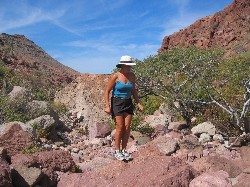
Rock climbing builds balance and confidence as one
becomes more and more in tune with Nature,
and your whole body begins to hum.
Every muscle tingled, our minds were soothed. In harmony with each other and this wondrous place that feels as timeless and and somehow as vast as the Universe itself, we walked down, boulder to rock, rock to boulder, amid the cacti, lizards, mountain flowers, succulents, and songbirds, until we returned to the white sand beach and blue-green water.
Garett: Our climb today reminded me of hiking up a creek bed, jumping from big rock to big rock. In fact, that is just what it was! This creek bed which drains the basin of the surrounding hills is dry 98% of the year but when a hurricane comes by in August or September and dumps 10 inches of water in 24 hours it must be a wild raging torrent.
The dried creek bed goes on and on as we hiked for about 2 hours up. I estimate we climbed about 1500 vertical feet which gave us the good views at the end.
PS: Casey and Amandah will LOVE this!

Finding a spot of shade amid the huge boulders.

After two hours, muscles tingling, we were rewarded
with this fabulous view northeast out into the
Sea of Cortez.
Carllie: When we got back to Light Wave, we saw a big school of tiny fish swimming in the shadow of the boat. They think LW is a reef, so we usually get some interesting fish swimming around the boat, but this was unusual and quite spectacular.

This huge school of tiny fish, maybe 2 inches
long, lingered in the shadow of Light Wave
most of the afternoon.
Garett – My Spearfishing Adventure
Garett: After our three-hour boulder hike, we were going to have lunch but decided that if we did we would probably need a siesta. So instead we decided to go for a swim-snorkel off the south beach. We loaded all our stuff into our ever-expanding gear bag (fins, snorkels, Lycra suits, weight belts and gloves) into the dinghy and motored over. The one extra component with us on this trip was my new spear gun. People had told us that in the Sea of Cortez you have to have a spear gun because you will catch so many fish with one. When we were in La Paz last week we did put our money down and bought a JBL 38 Special. A 38-inch spear is propelled by two huge surgical rubber tubes that you carefully, and with much effort, pull back and hook onto the spear part for propulsion. It has trigger mechanism just like on a gun and of course a safety switch so you don’t accidentally hurt yourself or a friend. You have to be very careful and never arm it out of the water or before you are at your hunting site. (C: or when your wife is swimming in front of you or below you!) This is a serious instrument. The business end of the spear has a couple of folding barbs that hold the fish on, while a 10 foot line attached to the other end has goes back to the spear gun so you don’t lose the fish or the spear if you should happen to miss (most of the time).

Brown pelicans peered at us as we dinghied to
a small beach on the south side to snorkel.
C&G: We pulled the dinghy up on the beach, struggled into our gear, then snorkeled out along the cliffs and boulders. There were a lot of reef fish, many of them small, as well as the too-pretty-to-eat and very beautiful angel fish (brown bodies with a white vertical stripes in the middle of their body, a splash of bright blue, and a bright orange tails), curious puffer fish – no meat on them but very curious and will come right up to the spear, tiny little fins circling while they hover. (Plus puffer fish are simply too cute to kill, right Korianne?)
Garett: I now had to start looking for the bigger fish. Eventually I spotted them, but they are very wary of anything big (like me) so immediately start to swim away, and they swim way faster than I do! I finally loaded up the gun and then saw an in-between size fish with horizontal stripes (don’t know the name of it yet), and fired. Amazingly, the spear went right through and snagged him. Wow! Is this ever easy! I didn’t have a catch bag attached to my weight belt to put my prize 10-inch fish into, so I had to swim back to the beach and put him in the dinghy. I then went back for more hunting. (C: With that first success, Garett was the one who was hooked! Finally I got cold so I swam back to shore, took off my snorkeling gear and sat in the shade of the rocks waiting for the Fearless Hunter to come in. He said he would be another 15 minutes because he was getting cold too. Two hours later…)
Garett: Little did I know that my first fish on that first shot was pure beginner’s luck, as I would now go three full days and probably 50 shots with both our simple Hawaiian sling and the 38 Special spear gun, without getting my second fish! I spent the next two hours circling the rocks looking for the right fish but had no more luck. You have to be at the right angle or else the spear will just glance off the fish scales. After two hours I was exhausted from the swimming, arming the rubber bands so many times while under water, and the effect of the cooler water. Believe me, if fish were only fished with a spear gun there would be no such thing as declining fish stocks in the world. (C: But then we aren’t exactly top fishermen either!)
I am getting better at tracking down the fish, but you have to be pretty close to have a good shot and to have enough power propelling the spear to snare the fish. It is definitely an art form, and I will just have to keep working on it and hopefully get better before we starve to death. (C: Literally, "fat" chance!)

Garett’s first speared fish, minus its head.
Funny, eh? (Forever Canadian)

The big treat after a day of hard
exercise: home-made pizza! No
meat, just lots of veggies, tomatoes
sauce and the queso pizza (pizza
cheese) we bought at C-C-C. The
pizza dough is courtesy of our
cruising friend Judy Lloyd from
Deja Too, and very easy to make.
When we get home, looks like we
can save $22 for our Friday night
Executive Vegetarian Pizza from
Zaccary’s on Oak Street! I will include
the recipe for Simply Great Veggie
Pizza on our Cruising Recipes sidebar
Friday April 6, 2007 and Saturday April 7, 2007
We spent two more idyllic days in Ensenada Grande. We swam, snorkeled, tried to spear fish (still no more luck). The only drawback was that the wind would come up from the southwest at about 6 pm until noon the next day and blow into the anchorage, making it a little rolly; but the scenery, the color of the water, and the peace of the place more than made up for it.
By the time we were ready to leave there were almost 20 boats anchored here. It sounds like a lot, but Ensenada Grande is a big place and we were tucked in at one end with nobody within 200 yards of us so it was really quite private.
Carllie: Actually, only on one or two occasions in smaller anchorages have we been anchored close to someone else, and close means 75 meters away, so it’s really not that bad for a short stay.

Wind picks up in afternoons at Ensenada Grande,
creating a little discomfort, even in our nice little
cat, with the swells rolling in beam-to.

Garett takes a "novel" break to enjoy a novel
in the warm afternoon breeze.

The Hunter and Provider!
With Hawaiian sling.
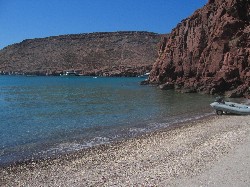
The small beach on the south shore at Ensenada
Grande. We snorkeled out next to the bluffs on the
right side and around the corner.
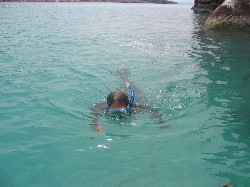
Still searching for the second strike.
He’s like me when I clam-dig:
maniacal!

Another beautiful sunset on our last day at
Ensenada Grande.
Sunday April 8, 2007
It was time to move on, so we headed out for 25 miles of hopefully downwind sailing north to the protected bay at Punta Evaristo.
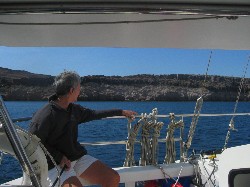
Leaving idyllic Ensenada Grande.
"Casey and Amandah will love this place!"

We had two bites on our hand-line
en route to Punta Evaristo.
Desafortunadamente, they were both
those yucky mackerel, so we didn’t
keep them. Lucky yucky fish.

The hand-drawn map of Punta Evaristo from one
of the invaluable cruising guides to this area,
Charlie’s Charts of the West Coast of Mexico
by Charles and Margo Wood. North is up
on the map.
Carllie: After an enjoyable passage sailing and motoring, we entered the very protected anchorage at Punta Evaristo in the late afternoon. As we expected winds from the south if anything, we turned left (south) on entering, where there were already 3 or 4 monohull sailboats anchored. However, as we usually do now, we motored in a little further into the shallower area, and set out anchor. Garett went down for a nap, as he had been at the helm most of the way over, while I gazed around the anchorage. It is a very pretty spot, and a couple of Mexican families including teenagers and little kids had set up their camp on the south shore during this week of Semana Santa. This week of Easter is a big holiday in Mexico. Forget the religious stuff, which as far as we can see isn’t a big deal in Mexico! About 99%of the people head for the water, with their tents, food and kids. Most of the people on this side of the Baja, unless they live in small fishing villages in more remote areas on the islands and coast, are forced to live inland due to the escalating cost of property on the water, thanks to the influx of Americans and a few Canadians. So, they look forward to getting to the cooler coastal areas and enjoying the water.
Sure enough, shortly after we had settled in, a panga roared by towing a young guy wobbling on two water skis. I called out to him, "Bend your knees!", remembering my water skiing days on Kalamalka Lake, but of course even if he could have heard me above the roar of the engine, he couldn’t have understood me! (I don’t know how to say that in Spanish yet! Ask me how to say, "Can you help me?" or "I want to buy some gifts," or "Do you live here?" or "Thank you for helping us.")

Mexican families enjoying La Semana Santa
camped at Punta Evaristo. Teenage sons
took turns water skiing behind a panga
in the anchorage, not too far from the
anchored boats!
A few minutes later, Andrew and Deb from the Catalina 34 anchored next to us, Swan, motored over to say hello. I had a nice chat with them while my social-life "groupie" (my definition of groupie: one who loves to be with groups of people and seeks them out, and this is Garett to a T) black-lab puppy slept below. I managed to have a pretty good conversation with them regardless. They are from my place of birth, Edmonton, Alberta, and several years ago trailered down on a Catalina 25 to the Sea of Cortez to see if they would like it. They did, but realized they would need a bigger boat to enjoy cruising, so they found a good used Catalina 34 that had been owned by a "dock weed" as they put it, who never left the dock and had the boat equipped with all kinds of 110V appliances, but no offshore equipment. So they had the boat trucked down to San Carlos, on the east side of the Sea of Cortez in the northern half, where they did some work on it to upgrade it, and keep it on the hard for six months of the year. They come down in November every year and enjoy cruising this beautiful, big area until early May when they return to Edmonton for spring and the more enjoyable summer and fall weather in that country that is cold beyond cold in the winter.
They are now in their sixth year of a planned 10 years of this arduous plan, and were happy to share with me their local knowledge: the locations of the tienda and agua purificada plant in this very tiny village, and their favorite anchorage next on the way north (Tambabichi).
I apologized for not being as chatty as my now slumbering hubby, and told them he is the social butterfly of the family, and would no doubt call them when he woke up to get the details on their favorite anchorages. As it turned out, he didn’t talk to them until a few days later when we were exploring Agua Verde.
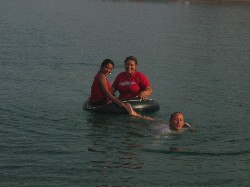
Three happy chicitas enjoying an inner tube
came over to say hello. The two on the
tube couldn’t swim, so Lorena towed them
while Erica held onto her big toe!
Before I could settle down to do something meaningful, I spied a big inner tube occupied by three laughing chicitas (teenage girls). They called over, "Hola!" with big smiles, so I waved and called Hola back. The one swimming towed the two on the inner tube over. They were all laughing, and the swimmer asked if she could rest on our swim ladder. So we had a nice conversation in Spanish, and I learned their names are (left to right) Erica, Erelico and Lorena. I found out they were on vacation (de vacationes) here, and told them that we are from Canada and traveled here on our boat. Very sweet kids. The Mexican people are very natural, and respond immediately to friendliness and kindness. At first glance they sometimes appear "sullen", but we soon learned that is because they are shy as a race, and as soon as you say "Beunos dias!" or "Buenas tardes" or "Buenas noches!" they give you a wonderful smile and respond in kind. By and large the teenagers are just as responsive as adults and children, and there is no "generation gap" creating the unnaturalness and unresponsiveness that we often see in Canadian and American children.
Monday April 9, 2007
Garett: Last night in the middle of the night all of sudden the wind came up off the mountains to the west that surround the bay. Within minutes it was screeching at around 30 knots. We had heard of this type of night-time diurnal wind which is called here “Elefantes”. It was soon howling and whining in the rigging. The moon was not up yet so it was still pretty dark out, which added to our uneasiness level. A fellow cruiser whom we spoke with later in day described the wind as “intense”. We think that was a pretty good description. We tried to think back to when we had more wind on our entire trip, and the only wind that might have matched it was when we were anchored at San Miguel Island, one of California’s Channel Islands, back in October, six months ago. Could it really be that long ? Here, we were only in eight feet of water and we had about 70 feet of chain and rope out, but we decided to let out some more, so we added another 30 feet to give us even more scope. Even though we were only about 100 yards off the beach to the west, one-to-two foot waves with whitecaps rolled towards us. After we had let out our extra line we were a little adrenalized and wide awake, so we decided to toast some of Carllie’s Irish Freckle Bread (newly discovered recipe, see Cruising Recipes) with some tea to wind down a bit and soothe our frazzled nerves. It blew for about 3 hours, but by 4 am it had all but stopped. It was a restless night in the sleep department.
We woke, however, to a beautiful clear morning. The most glorious times of the day here are at sunrise and sunset as the sun at its low angle creates dramatic lights, shadows and contrasts on the surrounding hills, bluffs and mountains. One of cruising books describes the sailing here “like sailing in the middle if the Grand Canyon.”
The weather forecast was for more south winds which suited us fine for next leg north to Puerto Los Gatos, about 25 miles away. We sailed for a couple of hours and then the winds died so we had to turn on the “iron sail” for awhile. Then, as we exited the channel between the Baja Peninsula and Isla San Jose, the southeast winds came back. This was good as in terms of sailing but bad for anchoring at Los Gatos as they would blowing right in, so we decided to pass on it and head another 20 miles to Bahia Agua Verde (Bay of Green Water).
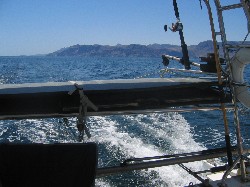
Our two hulls kick up quite a wake because
the transoms drag in the water. Garett plans
to remedy this in our boat building month
at Guaymas, coming up soon.
The scenery along the coast is really indescribable as the jagged mountains shoot up right up from the shore. The mountains have these distinctive strata layers of various colors blending from black to grey to green to pink to clay red, and are very sharp as they have never been worn down by glaciers.
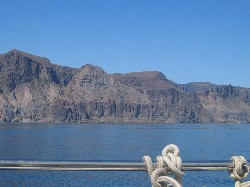
Dramatic colors and shapes of mountains
plunging into the sea, never "dulled" by
glaciers.
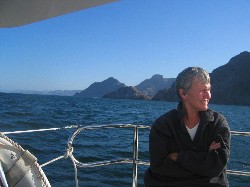
It is rare to don a sweater, but while under sail, until
the sun is high it can be a little cool.
As we entered Bahia Agua Verde we motored past a few big power yachts and anchored between some new friends we had met in Ensenada Grande, Candy and David on Chinook, and the beach.

Getting ready to set the anchor at
Bahia Agua Verde.
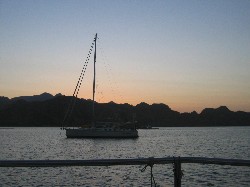
The end of another perfect day,
nestled into Bahia Agua Verde.
Tuesday April 10, 2007
Carllie: Today was a great day for exploring, by land and by sea. Bahia Agua Verde is a big area, with about three anchorages: the cozy southern cove where we dropped the hook expecting winds from the southeast; a smaller area just off a spit in the northwest corner; and the big open area in the middle where two or three big power yachts had anchored. We were anchored near a Moorings 42 catamaran chartered from La Paz, that we recognized as we had toured the Moorings cats before we left the city. The Petty family, from Newport CA, were having a great time. We saw the kids climbing all over the boat the night before, playing hide-and-go-seek in the mainsail cover on the boom, laughing and having and staying up late. Why not? At $7,000 a week they’d better enjoy every minute! We got to know this family better later.
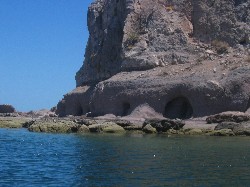
The dramatic rocks and cliffs that we
snorkeled near, eventually.
On our way out to explore the beach on the north side of the bay, we took a picture of the very dramatic rocky bluff on the east side of our little cove, where we snorkeled later. It is a good mile across the bay, and we had a nice little hike when we got to the northern beach, and took some great pictures of the bay. We also spied Swan, with our new friends Deb and Andrew whom I had met at Punta Evaristo, anchored off that northern spit, so we stopped by on the way back so Garett could meet them. Garett’s pure enthusiasm and joie de vivre is so contagious and everyone responds to him, so we had another nice chat with them.
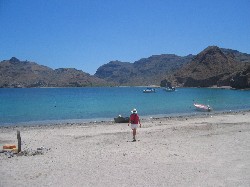
Exploring the north beach opposite the
bay where we anchored.
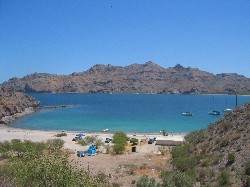
View of part of Bahia Agua Verde. We are
anchored to the right in the distance, not
in the picture.
They also told us how to find the tienda in the town, so we motored over to the southwest corner of the bay, hauled up the dinghy,and walked up the dusty road a short distance looking for the tienda. We did see a small concrete block building that was locked up tight that we thought might be the tienda, and a friendly muchaco by the name of Marco, who was happy to practise his English with us while we practised our Spanish with him, confirmed it, advising us that the store would be open at 3 o’clock: "Esta abierto a las tres." Like most store owners, they take a siesta between noon and 2 or 3 o’clock in the afternoon. As this is a very small village, there is not a steady demand for their goods. It was quite funny as two young Mexican women arrived in a car a few minutes after we came back at 3 o’clock. Eventually, they yelled to their friend who owns the tienda, "Monica!!! blah blah blah" in Spanish (can’t remember the words now), obviously telling Monica she had customers and she’d better open up! All done with great goodwill and big smiles. Monica soon hurried out from her home behind the tienda, with mama in tow, opened the tienda, and immediately had six customers. Everyone is happy.
Everything is so much more relaxed here, so much nicer. At home, everything is "perfect": stores open at 9:30 sharp, and close at 6:00 sharp, or whatever. No one ever closes the shops for siestas; they just get grouchier as the day progresses and they get more fatigued. (Which reminds me: I usually had a little nap during my lunch hour when I was working in offices at home. Everyone including myself thought I was weird, but now I know it is a normal and healthy habit!) The sidewalks are all the same dimensions: 6 inches high (or whatever), with ramps for wheelchairs. In Mexico, sidewalks range in height from block to block, anywhere from four inches to three feet above street level. They have unexpected holes in the middle of them, or obstructions sticking up. So what? It’s not perfect, but Hey! The people are happy. We pay pretty hefty taxes for "perfect sidewalks" among other things. And the hefty taxes keep us working like rats in a maze 5 days a week, 8 to 14 hours aa day, depending on how hooked we are into the system.
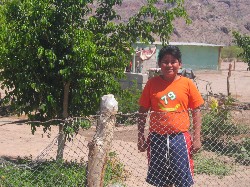
Marco was very helpful showing us where
the tienda was located. His aunt eventually
made us a dozen fresh tortillas, about 8" diameter,
for 120 pesos ($1.20). What a deal! They
were still warm when we got them.
A brief Spanish lesson: While waiting for the tienda to open, we walked around the village chatting to Marco (we spoke Spanish and he answered in English, very funny). He ended up at a house owned and occupied by his aunt, uncle and some cousins, and we noticed a sign stuck up on the fence saying "Tortillas". I walked up to the entrance to the house, under the cooling palapa and called through the window, "Hola senora! Tiene unos tortillas?" (Hello madam. Do you have some tortillas?) The friendly lady who appeared at the window looked flustered for a minute, then she asked how many we wanted. I said, "Dose" (12) and asked her "Quantos questa?"( How much.) She said, "Cien y vente" (120 pesos, about $1.20 US). I said "Bueno!" She said, "En cinquenta minutos?" (In 15 minutes?) We said, "Si! Gracias! Hasta luego." (Yes. Thank you. See you later.) Then we walked over to the tienda, bought some tomatoes, bananas, Herdez salsa, tostadas, and Fresca soft drinks.
Returning to the Aunt’s home and waiting for the promised tortillas, we met Marco’s sweet little cousin, Alandra, whose picture we couldn’t take because our camera was out of battery power, and her brother Jordy. They were such sweet children, and we talked in Spanish with them as only Marco knew English, telling them where we were from, asking them where they were from. We drew a map on the sand in their front yard and showed them where Vancouver is. They were vacationing at Agua Verde during Samana Santa (Holy Week – the week before Easter), and live in Los Cabo, near Cabo San Lucas on the southern end of the Baja Peninsula. Eventually, Aunt came out with a nice vacuum-sealed package of fresh hot tortillas, about 10 inches in diameter. Just yummy. We had a couple as soon as we got back to the boat, and enjoyed them over the next few days with warmed refried beans, guacamole, and Herdez salsa. Mmm-mmm good.
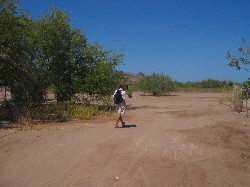
One of the roads winding through the
little village, looking for the tienda.
When we got home, after our tortilla treat, we donned our snorkeling gear and swam over to the nearby bluffs, that we pictured earlier. I looked for reef fish to admire and visit and practised my free diving, while Garett looked for fish to spear for dinner. Such a meany. He free dives constantly while spearfishing. Free diving is a great exercise, as you have to hold your breath (obviously), and dive, then relax while you are on the bottom, regularly pressurizing your ears, and at least once releasing a bit of air through your nose when the mask presses against your face. The pressure of the water seems to stimulate the body and strengthen it, and forcing out all the stale air laden with CO2, taking a very deep breath and holding it is also good exercise. Plus as a new cruising friend, Casey, recently pointed out: it’s a mind game to talk yourself into relaxing while you are down there. As soon as you get anxious, you use up more oxygen. If you just relax and enjoy it, you can stay down longer than you think.
Spear Fishing Part 2
Garett: After our walk we were hot and sticky so as Carllie said, we decided to go for a swim and snorkel. We swam the 100 yards over to the rocky cliff to see if we could spot any fish. I brought my Hawaiian Sling with me this time which is different from the spear gun that I had used on my previous foraging expeditions. The sling is a six-foot pole with three prongs at one end and a big surgical tube on the other. You hold the tube in your hand and then slide it along the pole towards the prongs as you stretch the tube. You then hold the pole in the armed position and when you want to shoot it, you release your grip on the tube and then it rockets forward as it slides through your hand in the direction you want, hopefully towards a fish.
The water was not very clear and there were very few fish, but we went out to the far point of the bay and then swam back along the shore. I hadn’t even tried to shoot at any fish as nothing got close enough. Just before we were about to head off from the shore back to Light Wave I saw a big black splotchy thing on a rock about 6 feet down. I dove down and it appeared on closer inspection to be just a sea cucumber or something. For fun I shot the sling at the splotch. Well to my total surprise it was fish and I had speared it. It immediately started fighting, and had to try to prevent it from wriggling off the pointy end of the sling. I was starting to run out of air so I made my way to the surface while pinning it to the rock, which wasn’t too far below the surface. It wasn’t that big a fish but it was sure the ugliest one we have ever seen. It turns out it was a Monk Fish, according to our best research. (C: Huge mouth, very bumpy, spiny exterior. Our camera chose to stop working, so we didn’t get a photo.)
When I got to the surface there was Spencer, one of the boys off from the family on the Moorings catamaran anchored next to us, on his kayak. He helped me keep the fish from getting away while Carllie swam back to the boat and got the dinghy. Finally, after 10 long minutes Carllie came back and we landed the fish. (C: I had to take off my Lycra suit, didn’t I?)
When we barbequed it later we found it wasn’t exactly the best tasting white meat. While it had the rough shape and chewy texture of lobster, it definitely did taste like lobster! Anyway, it was fun to finally get another fish. I have to go after some bigger fish but this will entail diving deeper which takes more skill. I’ll keep working on it.
Wednesday April 11, 2007
We dinghied ashore early this morning for a little morning walk and to do our exercises, and then made our back to the boat.
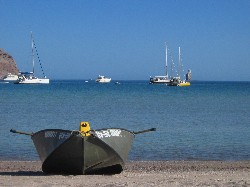
Our dinghy waits for us while we explore the
beautiful beach off the southern cove where we
anchored. You can see Light Wave on the far right
in the bay. What looks like a bag on her bow is
actually Roca Solitaria in the distance.
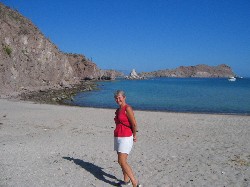
Enjoying last walk on the beach before
we leave Agua Verde.
While going back we could see the boys on the Moorings catamaran were jumping off the back arch about 8 feet above the water so we went over to watch and take some pictures.
We started talking with the family and they promptly invited aboard, so we chatted about our trip and all sorts of things for the next hour. The Petty family is from Newport Beach , California, and though they own a Catalina sailboat they often take family vacations on chartered catamarans. They agreed that one week just wasn’t enough for the Sea of Cortez but better than no week.
Here are some photos from our visit with the Petty family on their chartered Moorings 42:
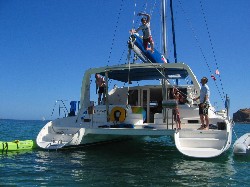
Spencer Petty, 10 years old, leaps from the
hardtop of the Moorings 42 catamaran
his family had chartered in La Paz.
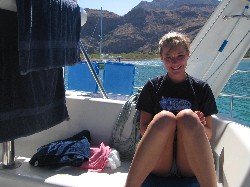
Taylor Petty, 13, happy aboard the
family’s chartered Moorings 42 cat.
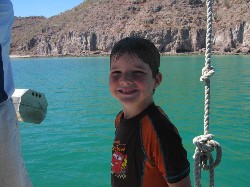
Cooper Petty, 6. What fun these children
had on their boat, and with visitors.
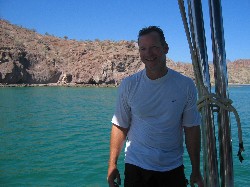
Dad, Doug Petty.
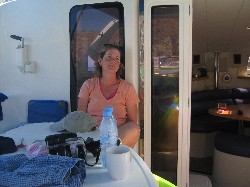
Mom, Leslie Petty. It was nice to get to
know the family. We hope they will
charter a boat in Desolation Sound one day.
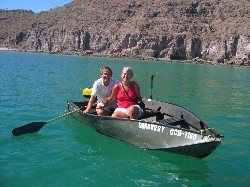
Since we are into pictures this is us
as taken by Leslie Petty .in the green
water at Bahia Agua Verde.
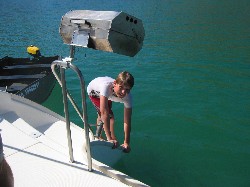
Spencer Petty, 10.
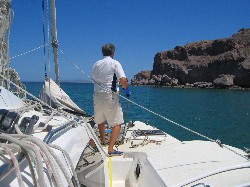
Garett Hennigan, 15 going on 50.
We finally made it back to Light Wave from our "morning walk" by noon, and prepared to head off to Isla Montessat, about 10 miles away.
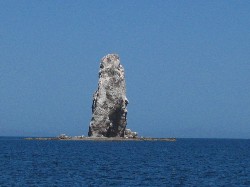
Roca Solitaria presented a very dramatic
picture as we reluctantly left beautiful
Bahia Agua Verde.
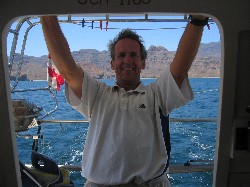
The Happy Skipper enjoying the
adventure he created.
About two miles out from Aqua Verde, I spotted a white blotch to the north about half a mile away. I should digress and say that for the last two months Carllie and I have been talking about getting some type of second vehicle to get to shore like an inflatable kayak or something. We even tried to buy a used one in La Paz but nothing worked out. So back to the white blotch… I turned Light Wave and we headed towards it. As I got closer I realized it was an abandoned (and quite beat up – lots of cracks and stuff) windsurfing board floating out in the middle of nowhere. I dutifully claimed salvage and we took it in tow. As they say, "You should be careful what you think about as you may get it".
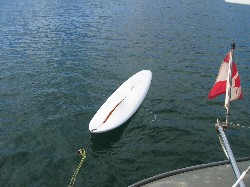
Our new kayak / waterboard.
Carllie: An aside here for my friend Korianne: as I was standing on the starboard transom struggling to snag the abandoned board with our boat hook, I spied a biggish black thing in the water on the other side of Light Wave. I pointed it out to Garett and for a minute we thought it was a dolphin, but then I quickly realized (a) dolphins don’t hang around by themselves, (b) they are rarely if ever still, and (c) this one had a tail fin as well as a dorsal fin. It was a shark. Duh-duh. Duh-duh! That got the hair on the back of my neck standing up. Almost as soon as we identified it, it disappeared. I briefly wondered (in one of my imagination-prone fantasizing moments) if he had eaten the guy on the wind surfer, and was waiting for his next meal! I continued working to snag the surfboard while very carefully maintaining my balance on the transom in the choppy water as Garett maneuvered the boat closer, and eventually succeeded. Anyway, not to worry as we don’t swim off the boat in deep water, and the places we snorkel are all pretty safe, i.e., no reports of sharks. Let’s not think about it anymore. (Too many novels, time to get real!)
Garett: After a few hours we went by an anchorage on the east side but it didn’t look too exciting or safe for that matter so we kept going around the island to the far north end, Yellow Beach. This anchorage is seldom visited because it faces north, the direction of the prevailing winds, and is an open roadstead anchorage. Since the winds were supposed to stay south for the next day or two, we decided to stay here for the night.
We got the dinghy together and made our way to the colorful beach and cliff. One of the advantages of going to these seldom-visited beaches is that they still have alot of fantastic shells. Carllie was in her element here and I even got caught up in the frenzy of picking shells.
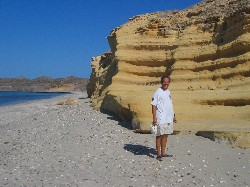
Beautiful yellow rock formations on beach
at Yellow Beach.
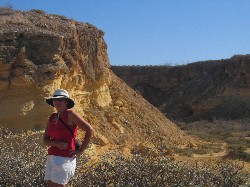
We could have hiked much further at
Yellow Beach, but it would have been
down into the valley, not across the island,
and there were…BUGS!
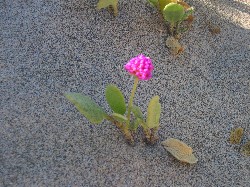
Flower blooms in the sand at
Yellow Beach.
/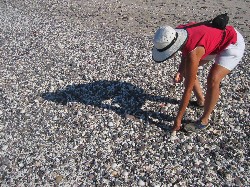
Surprisingly, the beach at this open roadstead
anchorage offered the best shelling to date.
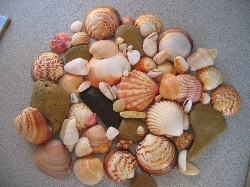
Today’s haul from shelling at
Yellow Beach. We also picked a few
unique, smooth rocks.
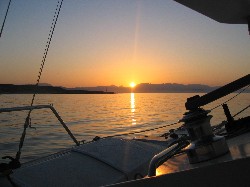
Day’s end at Yellow Beach, an open
roadstead anchorage, but fine for one night
in the southeast winds.
The wind did come up from the south about 15 knots during the night. Although we were protected from most of the waves, the swell did wrap around the point and so it got a little rolly through the night so our sleep wasn’t the best ever.
Thursday April 12, 2007
We left Yellow Beach early and made our way back to the Baja side and some of the islands closer in. We had a pleasant sail past Danzante Island and Puerto Escondido but decided not to stop.
Carllie: Puerto Escondido used to be a favorite anchorage for cruisers as it is very beautiful and a perfect hurricane hole, about a couple of years ago the Mexican Government claimed the bay and placed about a hundred mooring buoys all over it. They charge an arm and a leg for these buoys, and we have been informed by many cruisers that the buoys were not properly laid, so you can’t trust them not to drag! They have taken up most of the bay with mooring balls, so you can’t anchor there anymore! Shades of the USA and Canada (particularly our infamous False Creek in Vancouver where they have for the past 20 years been trying to prevent cruisers from anchoring in spite of the inalienable right of every person to have right of safe anchorage in a harbor).
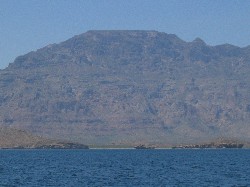
The mountains became even more dramatic
en route to Puerto Ballandra.
Garett: By about 3 pm we had finally arrived at our destination of Puerto Ballandra which is a one mile wide deep cove at Isla Carmen.
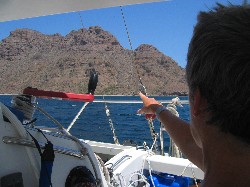
Approaching the entrance to
Puerto Ballandra.
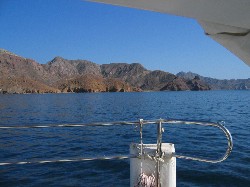
View from our anchoring at
Puerto Ballandra.
After settling in, we decided to snorkel over to the nearby cliffs. The water was a little cool, visibility wasn’t great, and there weren’t too many fish. We both practised our free-diving, and I looked for something to spearfish. I did find on the bottom in 10 feet of water a big shell which I though was a really big oyster. (C: and he made me carry it home while he continued spearfishing. The darn thing was so heavy it almost drowned me when I stopped to look around while snorkeling, as I could hardly get my head above the water. I figure it added 3 pounds to the 6 pounds of weight I was carrying on my belt.)
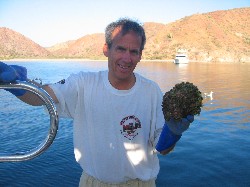
Garett with his big "oyster".
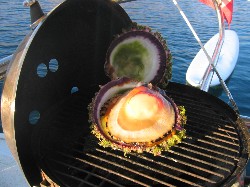
The oyster turned out to be a big scallop. When you open
a scallop, the "guts" surround the scallop muscle, which
is what you eat. Yuck.
Carllie: We did finally get Garett’s "oyster" steamed open, only to find that it was a huge scallop, not an oyster. When we extracted the scallop muscle from the surrounding guts, we fried it and it was quite delicious though a little tough. We later found out from fellow cruisers on a big megayacht that you have to pound scallop muscles before you cook them (like people tenderize meat, I gather). So, next time we will know (a) what to look for as scallops are delicious, and (b) how to cook them.
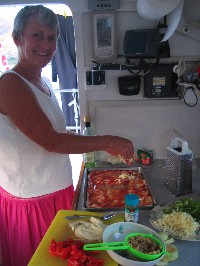
Carllie prepares our second
veggie pizza (a week after the first).
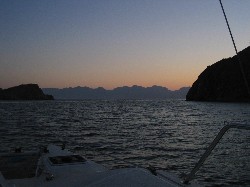
Our first sunset at Puerto Ballandra.
Friday April 13, 2007
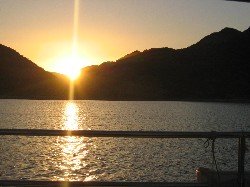
Sunrise at Ballandra.
Carllie: We had used all the water in our big water tank (20 gals) and were starting to use our separate containers of water, so we discussed when and where we would next get water. Well, there are two big power yachts anchored about half a mile across the bay, and Garett says, "I’ll go over and ask them for water!" Cringe! "What?" I say. "Sure," he says, "I’m sure they will be happy to give us some water." I reluctantly say "Okay, but tell them we’ll give them a loaf of banana bread for the water."
Well, as I say there are two big yachts, but one is much bigger than the other, though they both look pretty skookum. The "smaller" one has a huge Canadian flag, so happily that’s where he headed first, while I started getting my ingredients together for my wonderful (if I do say so myself!) Banana Bread (see Cruising Recipes). Half an hour later, I see our dinghy tied behind the Canadian yacht, and 20 minutes later it hadn’t moved to the American yacht. Garett was gone so long, over an hour, that I figured he’s either having a great time with these folks or else they had drowned him.
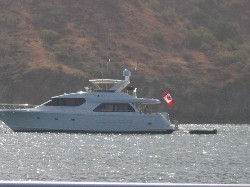
Serenity Now at anchor in Puerto Ballandra.
The Canadian flag clinched it: this was the
yacht where Garett asked for and received
the water we needed.
While the Banana Bread was baking, Garett charged back in the dinghy, all smiles and chuckles and happy to tell me about his new friends, Bob and Roxy Engle on Serenity Now. He says they are happy to give us all the water we need, and want us to come over for cocktail hour at 6 o’clock. Well, I am glad Garett is so cosmopolitan he has the nerve to make these overtures to other people, because as a result of his efforts we made some great new friends.
As soon as the banana bread was out of the oven and cooled a bit, Garett zoomed it over to Serenity Now. As soon as he got back, we took off for a long hike on shore with our friends Andre and Claire from Neaouli. They are a French couple we had first met when we were all excitedly sharing dock space at San Diego before embarking on our big adventure down the Baja Peninsula. Claire has been sailing since 1964! Andre joined her adventures about 10 years ago we think. They had been living, working and cruising in French Polynesia for many years, and recently spent a whole winter in Prince William Sound in Alaska, and a season in Victoria, B.C.
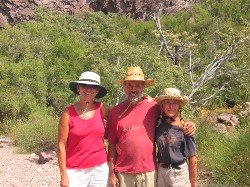
Carllie with Andre and Claire from Neaouli,
all ready for a hike!
We had just over two hours for the hike, to get back in time for our visit to Serenity Now.
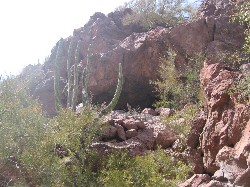
This hike was mostly along a dry riverbed
that during a big rainstorm (Chubasco) or
hurricane must be filled with rushing water,
as the bed is dug very deep, the big stones
smooth, and the small river rocks piled deep.
The walk, though not as long as the boulder-climbing hike at Ensenada Grande, was hard work because we had to walk through smaller boulders and on the deep layers of small river rocks that sink under your feet, thus making forward momentum difficult. It was very picturesque and enjoyable–lots of tiny lizards skittering off the path and chipmunks scurrying away, while we heard the drone of honey bees and the sweet songs of songbirds. It was another hot day, and in this valley, the warm air buffeted us as we made our way slowly higher and higher. Unfortunately, we did not have time to get all the way to the other side of the island on this hike. Andre and Claire knew how to find rocks with crystals inside so we did a lot of rock-picking and smashing.
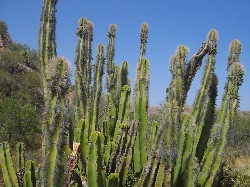
Tall cacti along the trail to the
other side of the island from
Puerto Ballandra.
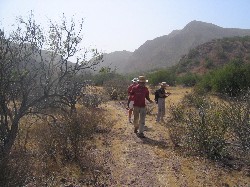
We walked slowly, looking for rocks, and stopping
frequently to take photographs.
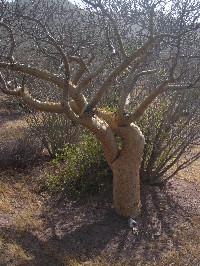
An unusual tree, waiting for the waters
that will come with the next Chubasco
or during a hurricane.
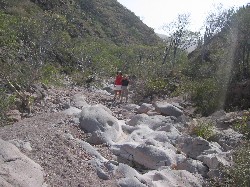
Our hike from Puerto Ballandra was
along a dry riverbed. Tough going!
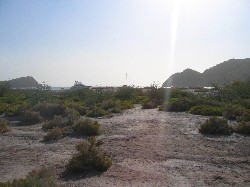
After two hours of rough hiking, we were
happy to see the water again through these
picturesque dessert plants and bushes
at the shorefront.
When we visited Serenity Now, Bob and Roxy showed us all over their beautiful yacht, and their engineer Gordy showed us their huge engine room and his own quarters that are located on the same lower level, though separated by a very soundproof door. Bob showed us his very advanced weather program on one of the computers in the "wheel house", and Roxy and I shared tid-bits about our favorite game, Scrabble. They also served us endless juice and some lovely hors d’ouvres made by their cook, Julio. We had a great time, though life aboard a megayacht is far different from life aboard Light Wave! As Bob is also a pilot, Garett had a lot in common with him other than the normal stuff that Garett has in common with everyone, so we hope to meet them again sometime. Maybe even in B.C. waters as they are shipping their vessel home via Dockwise in May, and spend some time every year enjoying our beautiful cruising grounds in British Columbia.
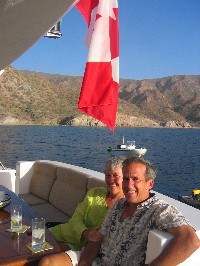
Guests on Serenity Now.
That’s the life! (Never mind,
Light Wave! We love you best!)
This is the kind of boat our friend
Jacine Tylor needs! Look up
SonShip 75, Jacine!
Happily, Roxy loves banana bread, so we felt we had given them some little thing they would appreciate in exchange for their generosity.
Saturday April 14, 2007
The next morning on our final visit to Serenity Now so Garett could help Roxy with a problem she was having with her computer, she loaded us up with special Serenity Now monographed T-shirts, a big container of nuts, and Relief Bands for seasickness. We were sorry to see them go as they gave us a big blast on their horn when they motored out later in the morning.
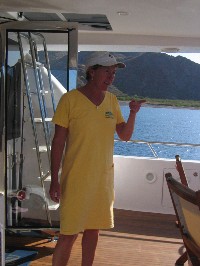
Generous lady of the ship,
Roxy Engle, in her morning
Light Wave colored dress.
We invited her to come with
us, but strangely she didn’t
take us up on the offer!
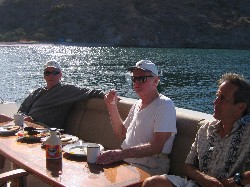
Morning on Serernity Now.
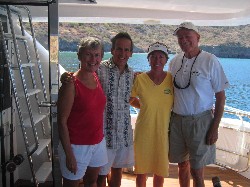
Saying goodbye to our new friends,
Roxy and Bob Engle on their
beautiful vessel, Serenity Now.
Garett: After our visit with Roxy and Bob we did another attempt to cross the island over to the abandoned town of Salinas. The day before we had gone 45 minutes out with Andre and Claire and we kind of thought it was just a little farther.
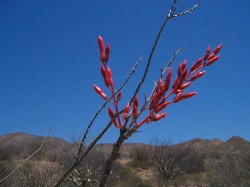
These red flowers bloom on
on the apparently desolate tree below.
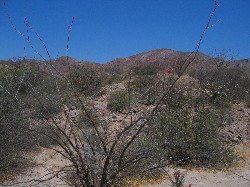
This is this barren tree from a
distance. You can’t really make
out the little flowers at the tips.
It turned out the trail went on and on through the mid-island desert that seemed to stretch forever.
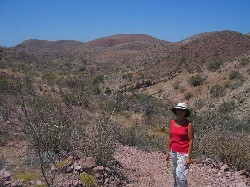
Here is Carllie just about ready to turn back.
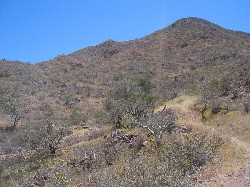
The endless trail ahead…and Garett gets
out his whip…
After a full 90 minutes, just as we neared the top a little further along the trail we spied a fox looking back at us. He paused for a minute seemingly entranced by these two-legged critters, then loped off quickly as we continued towards him. Suddenly, at the top of the ridge, below unfolded this beautiful vista of the aquamarine light blue of the salt lake, separated by the white sand beach and the deep turqoise blue of the ocean. It was spectacular. But there was no way I could convince Carllie to climb down to the lake knowing we would have to climb back up to where we were.
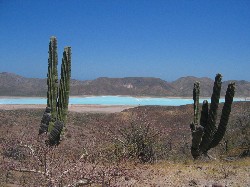
The abandoned salt ponds of Salinas.
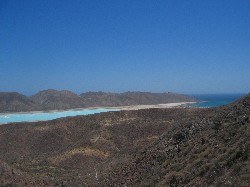
The abandoned port and town of Salinas
separates the salt lake form the ocean bay.
After taking some pictures and a water break we were off on part two of our march which took only 75 minutes back to the boat.
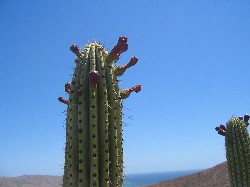
Small cactus flowers bloomingt.
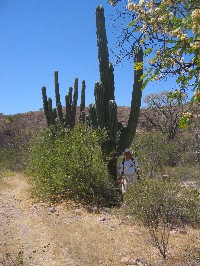
A mega 25-foot cactus and Garett.
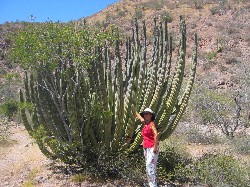
Carllie with another type of
multipronged cactus.
The total hike was almost three hours and we were pretty tired. We had a quick swim (no snorkel as the water had dipped to 67 degrees F. because of the wind yesterday) and called it a day.
Sunday April 15, 2007
The winds were calm so we picked up our anchor and motored the nine miles over to the town of Loreto (pop. 7,500). We anchored in the roadstead (means wide open anchorage with no wave or wind protection) and dinghied into the small darsena reserved for pangas.
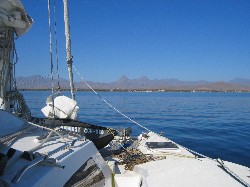
Approach to Loreto in a flat calm.
Carllie: We understand that many Americans live in Loreto or have vacation homes here. Friends we met back at Bahia Los Frailles in December, Mick and Joyce on their big cat Rumline, were on their way to Loreto where they would be living after retiring from their vocations in San Diego. The town reflects the dissonance between American and Mexican cultures, I think. There are much fewer Mexican people, and those we saw were not as friendly. Perhaps they feel disenfranchised. It is a pretty town, though, and there is an interesting museum that we would like to visit, plus some nice shops (!!!) So we look forward to exploring it more thoroughly in the fall, when it’s not a Sunday!
Garett: Loreto was a nice little town and we hope to spend more time there in the fall. It was Sunday and so there wasn’t too much open, but we picked up a few groceries and quickly made our way back to the boat. We pulled up the anchor quickly so we could get going on the 35 miles to San Juanico so we could get there before nightfall.
A navigation note is that our digital chart plotter with GPS that we use for navigation has built in charts for our entire route. The charts up for Canada and the USA are very accurate as in they will show your position right on the dock in a marina. Most of the marine maps for the Sea of Cortez were done along time ago (probably by Senor Cortez himself) and have not been GPS corrected, so many times when we are close to shore our Garmin 178C Chart Plotter will show us over land. (We have often anchored on land!) There appears to be about a one mile error. This means that night time navigation close to shore is not recommended so you try to be safely at anchor by dark. We did arrive in the night at Bahia de los Muertos back in December, but we were okay. In these circumstances, you have to carefully use your radar to make sure you don’t run into land and rocks, and use the cruising guides that warn of any reefs extending from points, or rocks under the surface in the middle of a bay.
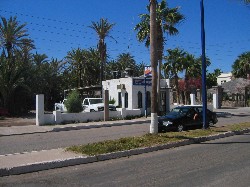
Neat streets and boulevard in Loreto.
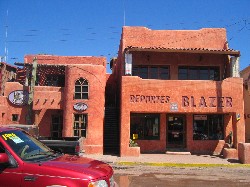
Interesting stucco buildings and shops.
We ended up motoring most of the way to Caleta San Juanico. Many of our friends who had already sailed up here had had told us that this is one of the must-see places in the Sea of Cortez. It was just as beautiful as it was described. The bay is about three miles long and has a series of beaches scalloped out of the rocky cliffs. At the far northern end there are several rocky spires and knobs behind which you can hide for good protection from most of the wind and seas. If your boat doesn’t draw much, like ours, you are able to sneak into the little nook between the big rocky islet (45 feet high?) joined to the land by a spit that is partially covered at high tide and the rocky spires on the east side almost into the shore where nobody goes, for even more seclusion–about 6 feet deep. That’s where we anchored, and the then spent the next five nights.
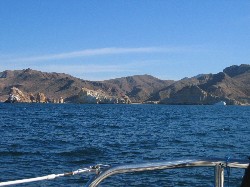
Approaching San Juanico.
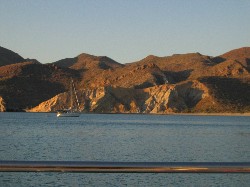
Our view out the cockpit at our anchoring spot.
Monday April 16, 2007
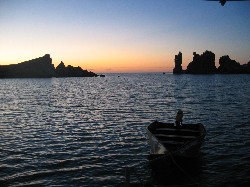
Sunrise in San Juanico.
We decided to some shore exploring and so we piled into the dinghy and scooted over to the north beach.
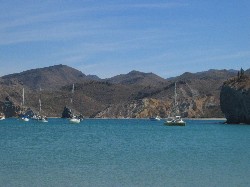
The anchorage at San Juanico, a very
beautiful spot where we stayed for 5 nights.
On the beach there is what is called a "Cruisers Shrine", a tree where cruisers have hung or placed interesting art objects, plaques and rocks with the boat name, crew’s names and date(s) they visited. One plaque we saw is dated 1982. There are a few hundred momentos, and it was interesting to look at them all, or as many as we could.
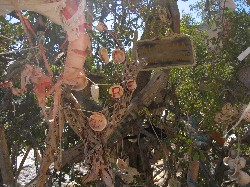
All sorts of art from sea shells, rope, rocks
wood, you name it, form the plaques where
cruisers have recorded their boat name, crew
names and date(s) of visit at San Juanico.
,
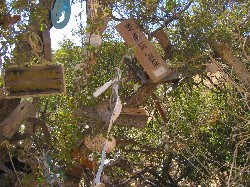
More boat names…
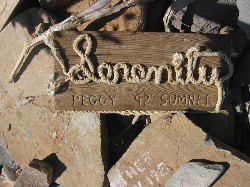
Another creative boat plague from rope.
Carllie: I found a perfect triangular shaped light grey rock with one smooth, flat surface. So we put it aside to paint later. A couple of days later, Garett went ashore twice and used our trusty yellow spray paint (with which we had painted the dinghy motor back in September), to paint the face of this rock with two coats. Then I used our big black felt pens to write across the bottom "Light Wave ’07" and across the top, "Garett & Carllie". Then I did one of my famous "stick drawings" of a very basic Light Wave in the middle. We placed it in a perfect spot at the base of the tree. It is right in front and stands out because of the yellow paint, so fellow cruisers who know us will remember us. Desafortunadamente, the picture we took of our rock was somehow deleted by our digital camera when we took videos of dolphin action a few days later. Our little Canon digital camera is getting a wee bit temperamental, so we think we’re going to have to shell out for a new one when we’re at home. We’re hoping to find a Canon 20D to take much higher quality photos for our magazine articles.
Garett: We then walked along the shoreline and over to the beach at Ramada Cove.
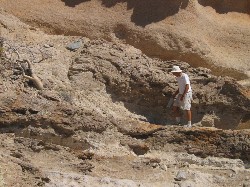
Prehistoric rock formations on shore.
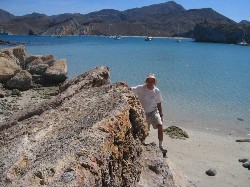
Garett the climber.
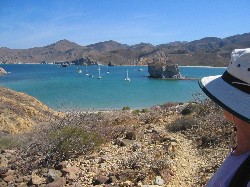
A view of the anchorage with Light Wave
in the front in the shallow area.
We walked along the gravel road to some nice houses that are perched on the cliff which appeared to be unoccupied and then made our back to the boat. We learned later one of these homes is owned by a Swedish Contessa, but they are all recreational homes and not occupied fulltime.
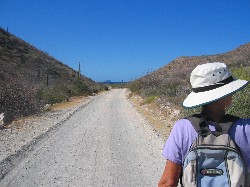
Walking the gravel roads at San Juanico.
We even saw a big jack rabbit but
no picture, too fast!
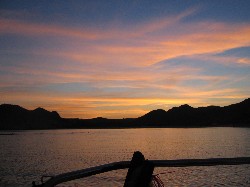
Beautiful sunset in San Juanico.
Tuesday April 17, 2007
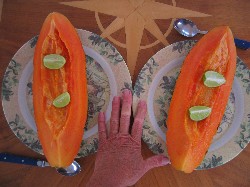
This is only one-half of the papaya we
bought at Loreto, for 120 pesos per kilo.
That’s about $1.20 US/kilo. Perfect breakfast!
After our papaya breakfast we became boat bound as the winds were 25+ knots almost all day long, so we lounged around doing some reading, boat repairs, and Spanish lessons. I did manage to go for a little dinghy trip around the anchorage to talk with some with some of the other boaters and commisserate about the gusty weather.
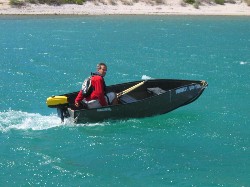
On one very windy day at Caleta San Juanico,
Garett took off in the dinghy for a quick
exploration. We had not dismantled the
dinghy when we left Ballandra as we knew
we weren’t going too far today and the seas
and wind were light. We then haul it up onto
the bow/net, and tie it down. Much simpler and
easier for Garett who is in charge of the dinghy.
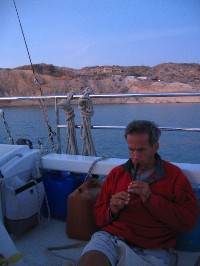
Garett is pretty good at playing "my"
tin whistle by ear. (He outstripped me so
fast, that I kind of gave up on it.) He
enjoys playing it, I like hearing it, and
I am sure others in the anchorage enjoy
it as well. I am now working at it again.
It’s either the tin whistle or the accordian,
the instrument played so cheerily and
cheekily in much traditional Mexican music.
By sunset the winds had calmed right down for another peaceful night in this glorious anchorage.
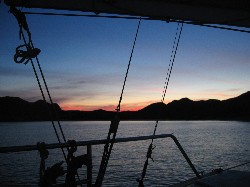
Another beautiful sunset at beautiful San Juanico.
Wednesday April 18, 2007
Carllie: Today was a “watermark” day (versus landmark). We wanted to snorkel off a rocky islet at the entrance to Caleta San Juanico; however, as it was basically a big rock sticking up out of the water, we were not sure how we would tie up our dinghy. The wind had died down, so conditions were otherwise good. We loaded up our snorkeling gear, hopped into the dinghy and motored over. Unfortunately, we did not take the camera, but we will try to take a picture of the rock when we leave Juanico in a couple of days. (Addendum: We did take a photo, but it was one of our pics that our camera mysteriously and crankily deleted later.)
Happily, on the west side of this rock there was a gradual shoaling of rocks, so I jumped out when Garett stopped the motor, and we were able to secure the dinghy to a rock on the micro-beach (about 10 feet by 10 feet). Una problema: black gnats galore. These are like itty-bitty houseflies that land all over you, but don’t bite (the locals call them "bo-bos"). They will fly into your eyes, your ears, anywhere that is exposed. Not fun. So we quickly donned our Lycra suits that cover the whole body, plus our snorkeling socks and gloves. With almost no skin exposed, things were much better (mucho mejor), so we pulled on our fins, donned our masks and walked sideways over the rocks until the water was knee-deep, then relaxed face-first into the water. No bugs at all now!
We have become accustomed to floating and swimming with our faces in the water. In fact, the transition period was not too long after our first snorkel back at Bahia Magdelena on the outside of the Baja Peninsula, back in November. Looking down into the sea, observing the reef fish, the starfish, the various types of rock and coral that line the bottom, all in total silence except for the sound of one’s own inhalation and exhalation, is a very peaceful experience. Here, one learns to love the sea and not to fear it. Fish rarely swim fast. Most of the time they are just floating, almost sleeping. Sometimes, when we dive, they will hide between a couple of rocks or behind some coral. But if we grab a rock and just relax once we are at the bottom, they will peak out, then come right up to you for a look-see. They are all very pretty, and quite endearing, so I am finding Garett’s new mania with spear fishing somewhat upsetting. More on that later.
Anyway, we swam out until it was deep enough to dive, then I practiced my free-diving around the islet while Garett looked for unwary fish. Eventually, he succeeded in spearing a parrot fish. As we have not yet invested in a sheath knife that Garett can attach to his belt to dispatch these unfortunate victims quickly, we had to swim back to the dinghy so he could leave his catch there. We decided that the best method for him to continue fishing was for me to follow him rowing the dinghy.
And a beautiful thing occurred while I was on the micro-beach taking off my fins and mask: I found my first murex seashell! In fact, it is a black murex, and here is a picture of it!
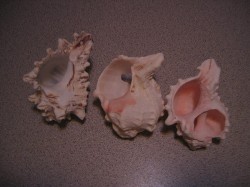
Black Murex on the left, with a couple
of pink murex
I was so excited, as these shells are unique to the southern regions. I am certain we do not have them in British Columbia, nor many of the other beautiful shells I have been finding down here. I had been hoping to find murex shells, and other smaller shells that are perfect for making beautiful earrings, so this was a big moment. Our friend Sunny Mathieson from Sea Scape had told me San Juanico had good shelling beaches, but we hadn’t found anything on the sandy beaches we had explored yesterday. It is on the beaches less traveled that one finds the more beautiful and desirable shells. This was proven out a couple of hours later…
Anyhoo, like any good wife, I rowed along behind my hunter hubby. When we rounded the islet where we were more exposed to the north waves, I applied my ever improving rowing skills to counteract the wave motion and avoid hitting Garett with row, engine or dinghy. Felt pretty smug about it too. The worst thing was sitting in the receptacle for his non-kills. The next poor parrot fish he caught struggled for about a half an hour before expiring, and it was all I could do not to throw him back into the water. In fact, I would have had I not visualized Garett’s disgust at such an action. Since then, I have laid down the law: no more parrot fish. It’s the big ones or nothing.
Eventually he got one more fish, and luckily he speared this one through some vital organ so that it died immediately. By then, even though he wanted to catch four of the little suckers, he was cold so he heaved himself into the dinghy, and we motored off.
It had been our plan to do some shelling after our snorkeling, and I was doubly keen now that I had my black murex in hand. We now realized that the less desirable beaches facing the prevailing north and northwest winds might yield the best shells. I also thought that the rocky beaches where there was no sand might be better, so we carefully made our way across a reef to a very rocky beach exposed to the north swell. I have pretty well mastered the art of jumping out of the dinghy as soon as Garett stops the motor, so that I can pull the dinghy up on shore before the next wave turns it around and bashes my shin bone. Nimble me. We won’t discuss age. Or size. Or shape.
The rocks have rolled up in waves progressively deeper and higher by the unremitting northern swell (much like Roller Beach at , so I waded through these deep troughs looking for shells. I was delighted to find some promising, beautiful fluted cone shaped shells, and got quite excited. At the top, exploring a little cave, I found another murex, this time a pink murex, and several more of these pretty fluted cones. Well, Garett went one way while I went the other, up and down these troughs, eyes peeled. Half an hour later we had a bagful of the most beautiful shells we have seen so far. Here are pictures of some of the specimens, along with a picture of our total haul for the day. I have all kinds of things in mind for these treasures of the sea when we get home. This is one thing we don’t have to declare at Customs. No tax on seashells, as far as I know!
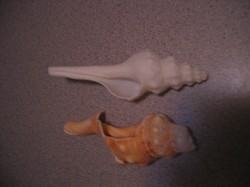
Thursday April 19, 2007
Garett: It was windy again today so Carllie spent most of the day writing our web update while I recovered (i.e. slept) to recover from my three hour snorkeling-fishing-hunting expedition yesterday.
Friday April 20, 2007
At 6 am we could hear the rattling of anchor chains going up on the various boats around us in the anchorage. The winds were calm so it looked like a good day to head north. We quickly got going by 7 am and we were off in smooth seas.
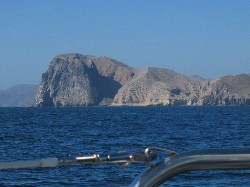
Sailing by the big rocky outcropping,
of Punta Pulpito.
After about 15 miles the south winds were strong enough to sail and so for about four hours we made good progress along the rugged coastline in the most pleasant point of sail: broad reach or downwind. (Carllie: Saling is much more pleasant and relaxinng than motoring, though our motor isn’t as loud as the diesel engines most boat have, nor smelly.) Throughout the day we came across several schools of bottle nose dolphins. One school had at least 200 of the friendly fellas. I sat on the bow talking to them, while Carllie took a zillion pictures. Here are the best two:
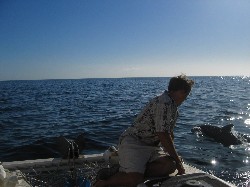
One dolphin passes us.
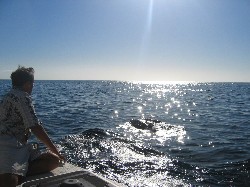
Two Dolphins zip by.
Eventually the winds died down, so we motored to the entrance to Bahia Concepcion where the winds picked up from the north which allowed us to have a great run south into this 25 mile long by 5 mile wide bay.
By 7 pm we were anchored in Coyote Cove. This is the first place since we left La Paz that the main Highway No. 1 runs along the shoreline. It has only two lanes but is paved (only in 1985 mind you) and extends from San Diego to La Paz. Thus, there are a few homes along the shore, and there are lots of 24 wheeler tractor trailers, but not nearly as many as I would have thought for such a main life line road. And surprisingly the sounds of their gear breaking did not carry enough to disturb us.
After setting the anchor, we checked to see if we could get a wireless internet connection off the boat here in the bay. Sure enough we got connected and were able to look at our emails for the first time in almost three weeks. One of the emails we received was from our good friend Richard Woods, the designer of our boat. He emailed us to say that a picture of our boat was on the front cover of the March April issue of Multihulls Magazine!
Here is the link to the cover:
http://www.multihullsmag.com/magazine/magazine.htm
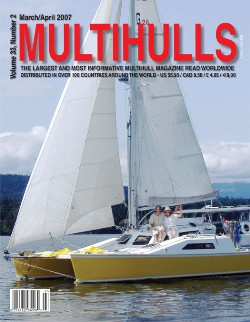
In this issue is also published Carllie’s article about the first leg of our trip from Vancouver to San Francisco, called "The Flexible Voyager". The picture was taken by Richard in the first week of August 2007 just off Salt Spring Island on our way south at the very beginning of our trip. If you want to buy a copy of the magazine to read Carllie’s article it is unfortunately not available at newsstands so you will have to call Multihulls Magazine directly to order one or email multihullsmagazine@aol.com, subject line: Email for Sue Daigle.
But more importantly as tonight was Friday, it’s Pizza Night again on Light Wave!Yippee!
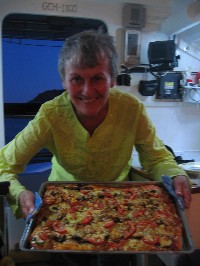
Carllie the master pizza chef!
This time it was Roasted Veggie
Pizza. Mmm-mmm good!
This was Carllie’s third pizza of the last three Fridays and this one was the best yet. It was just like a Vegetarian Executive from Zachary’s Pizza at 15th and Oak in Vancouver…. sun dried tomatoes, roasted garlic and veggies; no feta cheese, but the Mexican queso pizza and fresh parmesan was a good substitute….ahhh! This recipe is also in Cruising Recipes.
Carllie: Cooking is very creative, and I am far more creative while sailing and cruising. It’s not just that we are piggies!
Saturday, April 21, 2007
Carllie: It was on that first night at Bahia Concepcion that the thought occurred to me: Why don’t we do our boat modifications in Guaymas now? Or at least in a few days, when we get there? We had planned to go to Guaymas now just to get an extension of our visas, then resume sailing in the northern Sea of Cortez. We were going to return to Guaymas about a week before we will leave for Tucson, June 18th, thence to fly home. Returning to Guaymas mid-September, it will be extremely hot, we hear anywhere from 110 to 120 degrees F., plus it is the rainy season and very humid. Boatbuilding in such conditions will be difficult, if not impossible.
When I broached the idea to Garett of hauling out now and starting our work right away rather than waiting until fall, I saw the light go on in his mind. He hadn’t thought of that possibility before either. We had made our plans back in January and firmed them up in March when we called Gabriel at Marina Seca Guaymas to ensure he could haul out our catamaran in mid-June and had room for us. Since then, the only adjustments to our plans had been in not having our good friends with us for a couple of weeks on our way north in the Sea.
It didn’t take very long for us to conclude that it is a pretty good idea to haul out and start our boat work as soon as we can get to Guaymas, and finish as much as possible before we leave for home.

Garett flipping pancakes. He’s the expert at
pancakes. We always have pancakes
when bananas get too ripe!
We had an uneventful night at Coyote Cove in Bahia Concepcion, hearing in the distance the grinding down of the 24-wheelers rumbling down the hill. There is quite a settlement in the nearby harbor. On the hill adjacent to our cove, there are several homes very sturdily constructed, Mexican style, of concrete and big rocks. We have since learned that this is a community of mostly American recreational homes.

Approaching the anchorage at Bahia Concepcion.
Sunday, April 22, 2007
We spent the day roaring (well, more like putzing with our 3 hp 2-stroke engine) around the huge bays in our dinghy. Bahia Concepcion is okay for a night or two waiting for favorable weather to do the northern crossing to Guaymas, but it really is not that pretty, and the water was murky and cool so we weren’t inspired to snorkel. We did go ashore at a few beaches hoping to find some good shells, but the bugs drove us away. Our last stop at San Juanico kind of spoiled us. Although we had been told there was a tienda and restaurant in one bay, we couldn’t find the store and the restaurant when we did find it was uninviting, so we continued exploring.

Anchored at Bahia Concepcion. Please note
the overall lines and look of Light Wave,
particularly her aft hulls, as they will soon change.
All the while during this long dinghy exploration, we continued talking about our plans and became more and more comfortable with our decision to do our boat modifications before we go home in June. We are at peace with our decision, and happy to have found a solution to the looming problem of the heat, rainstorms and even possibly hurricanes in September. Now, it’s just a matter of getting to Guaymas, getting hauled out, buying a bunch of fibreglassing and epoxying supplies plus a few tools, setting up our workshop, and going at it. Our boatbuilding endorphins are surging, and we can hardly wait!

Looking for a restaurant on a beach
at Bahia Concepcion. This one looked
dismal, and it was.
The Amigo Net weather broadcast that we had received that morning predicted very light variable winds for tonight, so we will cross tonight. As the winds always pick up in the afternoon on the mainland (east) side of the Sea in the form of land breezes from the east, we want to get there as soon as possible during the day, so we will leave at about midnight.
Our boatbuilding buzz kept us from resting after dinner, as we usually do with such a plan. We each laid in our respective berths tossing and turning, until finally I got up and said, "Why don’t we just go now?" It was about 10 p.m., and Garett immediately agreed. We did some refreshing exercises to wake ourselves up, pulled up the anchor, and quietly motored out of the long entrance to Bahia Concepion in the dark, using our radar and following our GPS track into the bay two days earlier.
We did have the benefit of a quarter moon, and the light of a sky full of stars. Within a few hours, we also had the glorious Milky Way, which is far more visible down here in the southern latitudes and provides much more ambient light. It was a nice departure, and the sea when we got out of the bay was very calm.

While motoring around the bays at Concepcion,
we were delighted to find, very close to where we
had anchored Light Wave, a pelican rookery!
Here is an adult pelican feeding a baby.
Monday, April 23, 2007

Sun rise crossing the Sea of Cortez to Guyamas.
What will sunrises and sunsets be like when we
make the big crossings to Hawaii and thence home
to Vancouver next year?
Morning en route back across the 90 miles of the Sea of Cortez to Guaymas on the mainland side: it was flat calm most of the way across. A few dolphins lanced through the phosphorescence in the water to play with us during our night watches, and provided welcome distractions from the tedium of a night passage. We took turns sleeping–me first, of course! I have to be sure to wake up from a sleep to take the watch as Garett will stay out there and not disturb me, getting more and more fatigued. I was pretty diligent, and he was well rested by the time the sun rose.
Just before 2 o’clock in the afternoon, a light northwest wind of 7 to 10 knots paid us a welcome visit. We immediately raised all sails except the drifter and were soon doing over 6 knots on a nice broad reach. About two hours from Guaymas, we began to get the sea to land breezes as well, and our speed really picked up. For the last hour before we reached the land where we would have to meander around a big peninsula to get into the City’s harbor, we were smoking at 7 to 10 knots. It was great fun, as fast downwind sailing always is.

I can’t remember what I was cooking here,
but I am having fun under way!

First views of the mountainous coastline
surrounding Guaymas.

The entrance to Guaymas is around this convoluted peninsula. The harbor is tucked around that peninsula cutting into the land, so it is well protected. In addition, a large island, Isla Pajaros, lies across the west entrance to the bay, adding additional natural breakwater. Here is a photo of the excellent sketch from Charlie’s Charts of the Western Coast of Mexico. Guaymas Harbor is on the right side of the picture.
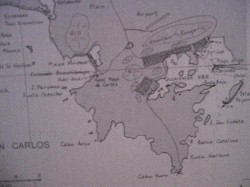
Guaymas Harbor is very protected–on right side
of this photo of hand-drawn chart. North is up.
Obviously, it is a good hurricane hole, and one that
insurance companies advise for their clients (i.e., they
require the owners of insured boats to stay or haul out
in specific areas during hurricane or cyclone seasons).
The boatyard is under the "G" in the fuzzy Guaymas
Harbor in this chart.
It is obvious Guaymas is a natural port, one which would attract invaders like the Spanish centuries ago. The city of San Carlos lies about 10-15 miles northeast of Guaymas, on the east coast of the Sea of Cortez. It does not have quite the protected harbor that Guaymas has, but has a couple of high-end marinas and a boatyard. Thousands of Americans live in San Carlos in their permanent or vacation homes, or on vessels moored at the marina. We like Guaymas as it is definitely Mexican. Its human history is very interesting, and we were glad to learn that the Guaymenas Indians, the indigenous people (read: those who lived here and so by natural law "owned the place"), repelled the invading Spaniards for three centuries. No doubt they were aided in their efforts by Nature’s hurricanes, torrential rains, and the searing heat. Here is a synopsis of the history from the website of San Carlos Marketing Company:
"The Guaymas area was occupied by the fierce Guaymenas Indian tribe [Ed. note: interesting how resident indians are described as "fierce"! This seems to us to be much like Iraquis defending their country today being called "terrorists"], which created enough resistance for the Spanish that they were not able to actually occupy the Guaymas area until the 18th century. The history of Guaymas, due to the early Indian inhabitants, dates back over 2,000 years. The Yaqui, Guaimas and Seri Indians lived in this natural habitat, sustained by the waters of the Sea of Cortez, which provided an abundance of food and the imposing figure of the Tetakawi mountain, which supplied the mystical powers for the spirits of warriors that so valiantly defended its shores.
"In 1701, Padres Salvatierra and Kino founded a short-lived mission settlement in Guaymas. The mission was soon destroyed by the Guaymenas Indians, but another attempt was made in 1769. This proved to be successful, and the new town of San Jose de Guaymas was named. Numerous small villages (camps) were located around the area, and the largest still remains inhabited and is located about 12 miles to the south of Guaymas with a population of 200.
"A desirable port city, Guaymas/San Carlos was occupied by foreign military forces and attempted by pirates. During the 1847-48 Mexican-American War, 2 US naval vessels, the ‘Eagle’ & ‘Reliant’ captured the San Carlos/Guaymas areas taking control of the harbors & town until late 1848, and then very briefly in 1853 by the ‘freebooter’ William Walker.
"1854 saw the French pirate ‘Captain Rousset’ operating in the Sea of Cortez. His pirate forces attempted to overtake Guaymas in a surprise attack with a well-armed group of 400. The battle, which lasted 4 days, initially overwhelmed local forces but by the end local militia forces remarkably managed to capture the pirate leader. After his capture and execution his surviving pirate crew disappeared and scattered into the seven seas!
"The area was briefly occupied again in 1865 by the French under Emperor Maximilian. The first two decades of 1900 brought revolution again to Mexico, and the port/cove areas suddenly became supply points for General Francisco (Pancho) Villias ‘Army of the North’.
"By 1910, ships from California, China, England, France and Germany were regularly unloading freight at Guaymas. While its import/export role declined, its commercial and sports fishing role gained in importance. Today, Guaymas is Mexico’s 7th largest port, handling approximately 4% of the nation’s total maritime cargo. The city’s large commercial fishing fleet brings in an abundance of Mexico’s fishing harvest – shrimp being the largest catch."
It was quite a long trip (5 miles) into Guyamas Harbor, and along the way we saw the big naval base (as far as Mexican Naval bases go, but about 1/20th the size of San Diego’s naval base) along the eastern shore of the peninsula. We made our way through a few islands into the bay in front of Marina Seca Guaymas (dry marina Guaymas), where we will be hauling out Light Wave. We anchored, tried our Internet WiFi connections, and found no unsecured wireless networks, so for the night we agreed to move across the bay to the downtown side of Guaymas.
Tuesday, April 24, 2007
After a surprisingly quiet night anchored off El Centro (downtown) Guaymas, we upped anchor first thing in the morning and motored the short distance across the harbor to the little cove off our boatyard. Motoring ashore in our dinghy, we had to tie up next to some Mexican workers building a new ramp for the boatyard. It has no beach and is deeply dredged so landing was a bit tricky and a bit mucky. Anyway, we tied up and then wandered around in Marina Seca Guaymas for awhile, checking out the boats already on the hard, and looking for Gabriel, the manager with whom Garett had exchanged emails and spoken on the phone. NB: the Mexican or Spanish name for boatyard is "marina seca" which means "dry marina".

View of downtown Guaymas (el centro) from our
temporary anchorage before we moved over to the
boatyard side.

We buy lovely fresh vegetables every chance we
get, and enjoy lots of variety. It’s great to be
vegetarians in Mexico, though the corn on the
cob here leaves much to be desired.
Eventually, we found Gabriel Larios Rizo, a very friendly expressive young fellow, who manages the dry marina (boatyard) for his father who owns the place. We soon realized we had chosen wisely. (Another interesting aside re the names of the Mexican people: when you ask someone his/her name, "Como te llama?" he will say his first name. But if you ask the name of his wife or daughter, he automatically says, "Maria Dolores", or "Nicole Esmeralda". And in signing their names or on business cards, these middle names are used.)
Marina Seca Guaymas is very boatbuilder friendly, and Gabriel is very helpful and accommodating. We arranged to be hauled out the next day, and confirmed that we will be staying in the yard until we return to Mexico in September. After I applied a little feminine wheedling and pleas (accompanied by prescribed batting of the eyes), Gabriel gave us the code for the secured wireless network. Edgar, one of the boaters whose boat has been on the hard here for a few months got Gabriel to set up the wireless internet in the yard, on the understanding he pays for it. Each visiting boater then pays Edgar a small monthly contribution to his costs. It’s a good arrangement and gives us excellent Skype and Internet connections for phone calls, emails and researching the Net, as well as very good connection to our Ares Ultra website from which we download movies and TV shows. This is a great way to relax after a hard and long day’s work in the hot sun.
We also scoped out locations of stores where we could get hardware, fibreglass and epoxy materials, lumber and groceries. Gabriel had no knowledge of laundry facilities, but in response to our query did tell us that there is a small hotel just down the road. When we visited it a few days later, I talked to the little old lady who was cleaning and asked her if she would do some laundry for us. She said she would, and when I returned a couple of days later with my big load of a month’s laundry, a young guy directed me to a little casa behind the motel on the beach. There I found Rosaria’s husband Chris (pronounced Krees), who was happy to take my laundry and said Rosaria would have it ready the next day. For 140 pesos ($14) I got two huge bags of laundry done. For the benefit of other residents or visitors at Marina Seca Guaymas, I printed up an information sheet advising folks how to find Rosario to ge their laundry done. I am sure she and Chris appreciate the extra income.
We caught another basic Mexican bus to town, joining a throng of Mexicans sitting on rickety seats, gears grinding as the driver raced pell-mell along, stopping wherever someone wanted to get off ("Bajan!") or waved him down. It is great fun to ride the city buses in Mexico. We hear the long-distance buses are very posh, however, and include air conditioning, television screens at each seat, and washrooms, and look forward to experiencing them for our 300-mile road trip up to Phoenix Arizona in June.
Walking around downtown Guaymas in the heat of the day, we explored every hardware store (tienda) that was open (siesta being from 12 noon to 2 or 3 p.m.), as well as a plastica tienda for fibreglass. We also stopped at a fairly large grocery store and bought a few things, and checked out the fish vendors on the malecon (waterside street).
Back at home, we were happily able to access Internet with our new code, got an excellent stable connection. That evening after dinner was a momentous occasion bringing us great joy, as we participated in a conference call home with lots of friends. We were amazed how clear the connection was, and thoroughly enjoyed the connection to our friends and the subjects we discussed. It is amazing what technology has accomplished since the days of folks like Eric and Susan Hiscock’s in their circumnavigations of the world that started in 1952 and continued right through to the mid-1990’s; not to mention the first (recorded) circumnavigation in a small sailboat by Captain Joshua Slocum between 1895 and 1898. He was the first man in recorded history to sail around the world around. Of course the Polynesians had been sailing across the oceans in their outriggers for centuries before that (read We the Navigators). I doubt they had sextants. Garett and I often wonder at those early offshore sailors like the Hiscocks. The only connection they had with their friends was through standard mail service, if they managed to be at particular port long enough to arrange for their mail to be forwarded to them; or I suppose with occasional very costly long-distance telephone calls routed through cables laid on the ocean floors. In addition, they had no GPS (Global Positioning Satellite) instruments to determine their position, so they relied on dead reckoning and triangulated their position with a sextant, siting the sun or more distant stars or constellations. We carry a sextant as a backup just in case we lose our electronics, but hope (fingers crossed) we will never have to use it.
Wednesday, April 25, 2007

Of all our travels down the coast and in the
Sea of Cortez, hauling out Light Wave in this
very narrow ways, with not an inch to spare
was the most harrowing.

We breathed a sigh of relief once she was
out of the water, but didn’t really relax until
she was safely secured on land.
The boat is out of the water now and sitting 75 feet from the office and showers.
This is the plan for our two modification projects in the boatyard over the next six weeks:
Part 1 ==> Extending the hulls 4
feet, to give more buoyancy, but mostly to improve the boat’s movement
through the water–the increased length will help to eliminate the "hobby-horsing"
our short little 28-foot cat had been doing in bigger weather. Plus, as
a boat’s speed increases concurrently with its water length (length of
the hulls in the water), our speed should improve. Plus, the aft of the
hulls (as of writing this) are now curved up through that additional 4
feet, so the very end of our hulls (transoms) will be out of the water
instead of dragging in it–this will result in much less noise, meaning
less stress for the crew as noise always causes concern, and less drag
thus more speed.

This pic shows the drag of the existing transoms
in the water: mucho noise, very uncomfortable
and unsettling for the crew, especially in night
passages, and of course slowing us down.
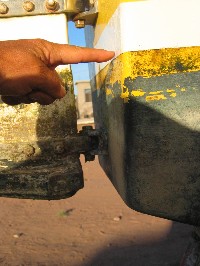
Garett’s finger shows how high the water
came up on the transoms. The area from his
finger down was dragging
through the water
slowing the boat, noise, and growth
on the rudder hinges. You can see the
lower hinge in the above photo but
that was only after scraping all the
barnacles off of them. The rudder could
barely turn anymore.
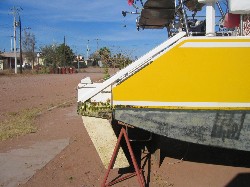
This shows the water mark on the
rudder box as well. Our new transoms are
raised out of the water, following the natural
curve of the existing hull line, and we are
sure they will be much better (mucho mejor!).
Part 2 ==>. Raising the whole cuddy cabin and cockpit sections 6 inches. Again, this will give our cat more clearance under the cuddy cabin, and so we will get less slamming by the waves: less noise and less stress on the crew and on the boat itself.
Thursday, April 26, 2007
Today was our big shopping day as Barry Squirrell took us around
town to the lumber, hardware, and marine stores in Guaymas and San Carlos.
We paid him in gas, as we don’t want to keep several gallons of gas in
the boat while we are away, and he was quite happy. Nevertheless, it was
a terrific help to us, and we really appreciated his willingness to spend
the time take us to the places we needed to visit.
Friday, April 27, 2007- Work starts!
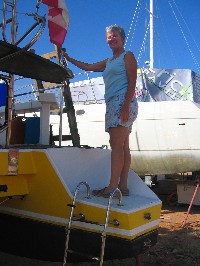
Last pic of the old transoms before
major surgery.

This is what the transom looked
like at before cutting and modification
with mean looking reciprocal saw.
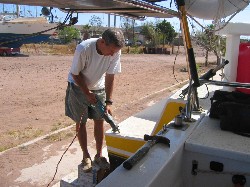
First cut. "Are you SURE we want to do this???"
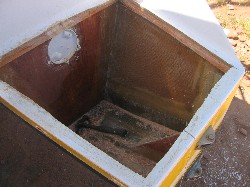
We are committed now. The top of one
aft hull/transom has been incised.
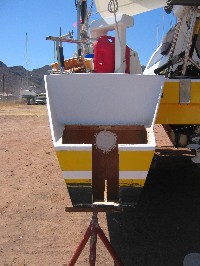
The look after first set of cuts.
Saturday, April 28, 2007
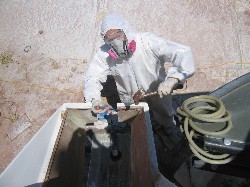
Garett cutting things up.
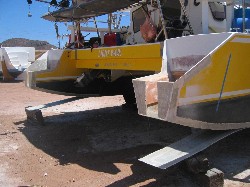
Both sterns cut off….yikes!
What are we doing?
The tongue shaped bottoms
are hanging down.
Sunday, April 29, 2007
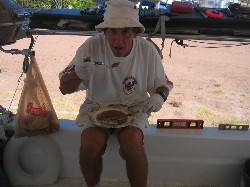
The boatbuilder takes a break. This is just
the beginning of several weeks of
intense work.
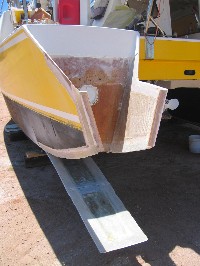
This is as bad as it looked with the
old stern cut off and the bottom
sliced back two bulkheads.
We are definitely committed
or maybe we should be committed!
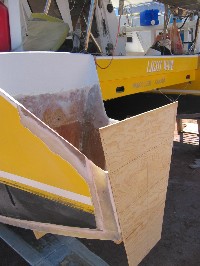
The much bigger replacement bulkhead.
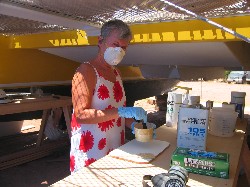
Uh-oh! I recognize that smell! Styrene! Here
I am mixing GRP resin again. Takes me back
to our boatbuilding days.
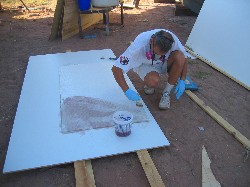
Wetting out our first pieces of fiberglass.
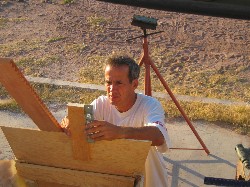
Measuring things up.
I finished cleaning out another sail locker (isn’t this interesting for you folks?), and again swept up all the dust and washed the floors in our living areas. Continuing my role as chief cook and assistant boatbuilder, I made a few batches of fibreglass resin for Garett, and also made breakfast and lunch. We had our afternoon siesta after lunch, and a bit later I made a huge potato carrot salad as well as a quasi-Greek salad. Quasi because the Mexican lady at the big Ley’s supermarket who sold me a big hunk of what she said was queso feta (feta cheese) in fact sold me the regular boring white Mexican cheese. And we all know that Greek salad is totally dependant on the tangy flavor of good feta cheese. Anyway, the reason for all this preparation was the regular Sunday night group barbecue in the boatyard. We all bring a contribution, some bring their portable barbecues plus fish and meat, and then we share and celebrate life on the hard.
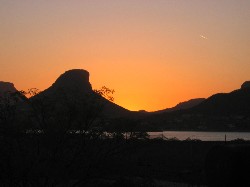
Beautiful sunset at the boatyard.
We are in an amphitheater of surrounding mountains.
Well, this was a barbecue to end all barbecues. We thought we were finished after we had had a big plateful of the salads I had brought plus some taco chips with homus made by another boater, and some big scallops barbecued by Barry Squirrell. We enjoyed chatting to everyone, which consisted of three couples and three single guys from their separate boats, and eating. After an hour or so, I meandered home a few yards to Light Wave where I snuck in a short preview of my now downloaded movie, Chocolat. About 10 minutes into the movie, Garett comes along and calls me back, "Carllie! You’ve got to come back! We’ve got tempura prawns now!" Chocolat would have to wait. Prawns beckoned. Back at the party, I found newly arrived Ted deep-frying in his wok big bowls full of fresh prawns and veggies dipped in his special tempura sauce. Well, Ted just kept putting out the freshly cooked tempura prawns, and we all just kept scooping them up, dipping them in his sauces, and munching. Tempura zucchini and carrots followed, all amid much good cheer and conversation.
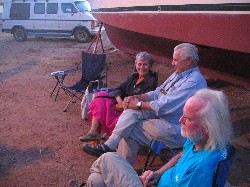
Our first potluck Sunday night barbecue
with the cruisers at Marina Seca Guaymas…
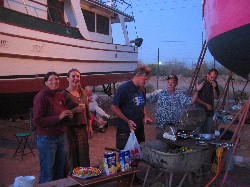
…was a lot of fun and provided lots of
fabulous food. We ate until we just about
burst.
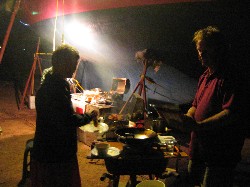
Ted, the expert chef and shipwright, deep frying
tempura prawns and veggies…yum yum!
Clint and Jacinda, a young couple from New Zealand, had finished their boat work for the day, and brought Jacinda’s fresh made chocolate truffles (!), and then after we had all stuffed ourselves with prawns, she produced a meringue topped pineapple mango cake from a Dutch oven they had brought over. This had to be the feast of all feasts, probably the best banquet we have enjoyed since we started our travels over nine months ago.
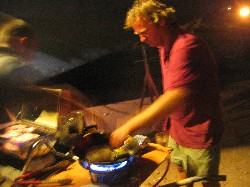
Ted with his deep frying wok
cooks up tempura prawns and veggies.
The best thing about these cruisers get-togethers, though technically this one included cruisers, temporary boatbuilders, and boatyard liveaboards, is the instant camaraderie we all share. We hear stories of travails one or more has experienced, and talk about the places we have visited and plans for future travels. This time, we talked about Barry Squirrell’s survival at sea with his wife, Toni back in 1997.
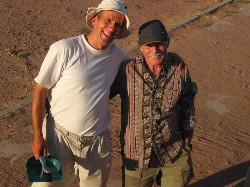
Garett with our new friend and volunteer chauffeur,
Barry Squirrell. Barry lost a few inches in height
when he was injured when he and his mate Toni
were sailing back from Guam and the boat pitchpoled .
They spent 142 days at sea in a jury-rigged boat.
They were on their way back to Canada from Guam when they met with a storm. Seas of 25 feet and pretty horrendous wind had the couple working hard to cope. Barry went below to make tea, and all of a sudden a 40-foot rogue wave hit, and the boat pitchpoled, stern over bow. Toni was four months pregnant, and when the boat was upside down she detached herself from her tether and swam up to the surface. (Don’t ask me how she did this in 25-foot waves.) Meanwhile, Barry was knocked out below and suffered several broken bones including broken ribs and collar bone. The submerged sail acted like an anchor, keeping the boat from turning all the way around as it naturally would due to the heaviest part of the monohull (the lead-stuffed keel) now being on top. Eventually the boat righted itself, and Toni found herself hanging off the back of the boat, caught in the wind vane mechanism. Every time the boat dipped into a wave, she would be submerged for several seconds, then she’d surface. She thought Barry had been killed in the pitchpole, and was sure she was also going to die. Meanwhile, Barry came to and somehow got out of the submerged cabin, before the boat righted itself. At some point here the boat rights itself. Somehow Barry made his way to where Toni was hanging onto the stern, got her to hold him up while he grabbed with his good arm, then hefted himself aboard, and pulled her up. They survived 142 days at sea with a jury-rigged mast and sail as their original mast and boom had to be cut away due to damage they had sustained and that the mast threatened to puncture the hull if it wasn’t cut loose. The amazing thing is that everything on the boat was functional, except the engine. Their heater and stove worked and they had food and water. So they were quite comfortable, however slow the boat was moving. When their rations were running low, they came across the American tuna fleet, which was on its way home. The fleet supplied the stricken vessel with three tenders full of supplies, certainly enough to keep them going. When they arrived in Victoria Toni was seven months pregnant!
Barry Squirrell is the elder brother of our good pal Ken Squirrell, whom we have been mentioning with his wife Wendy and their boat Cop Out as we had been travelling together down the coast and in Mexico. Barry has a bright pink monohull, and when we were wandering through the yard that first day, when we saw the boat we made all kinds of uncomplimentary comments: "Look at that pink boat!" "Who would ever want a boat that color???" "It’s a Mary Kay boat!" etc. We continued walking, and saw Barry standing beside his boat. Boy, were we embarrassed. This was not the first time we have been caught out making derogatory comments about someone else’s boat, especially me. I have learned, or thought I had learned, to keep my mouth shut until we are well away from the boat. Luckily it appears Barry didn’t hear us, as we later became fast friends, and shared many jokes about his brightly colored vessel. On later reflection, I realized that painting your boat such an unforgettable color is good–because people never forget your boat, and if anyone is ever looking for you, everyone will remember where they last saw you. In fact, Barry said he decided on fuscia colored boat with purple trim when he was last sailing in French Polynesian. The colors of the water, the sky, everything there is so vivid, that he decided he wanted a boat just as bright and happy that would fit into these colors. We like our yellow color, which is also rarely seen, but not as infrequently as hot pink!
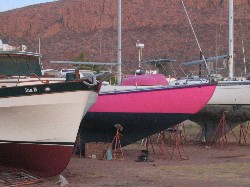
Barry’s bright pink boat is hard to miss.
He wants to fit in with the beautiful colors
in French Polynesia when he visits
next spring.
Monday, April 30, 2007
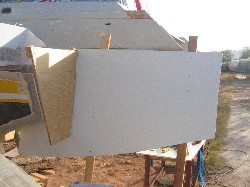
Inside of one starboard mold.